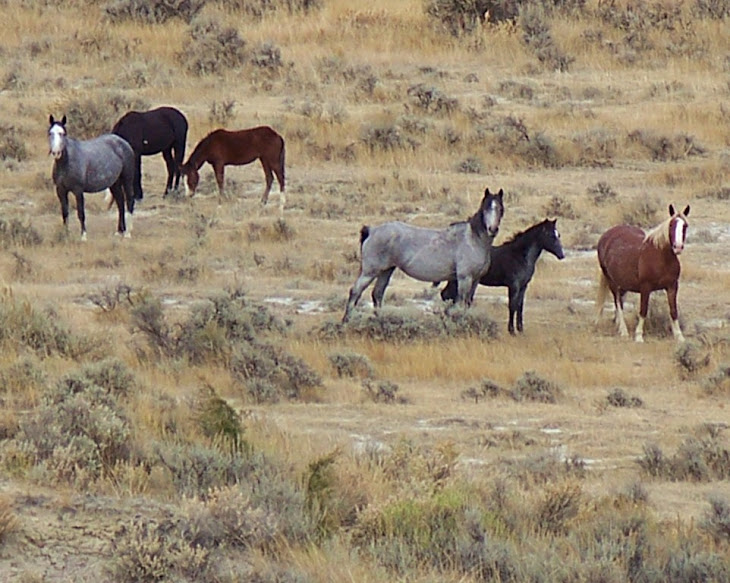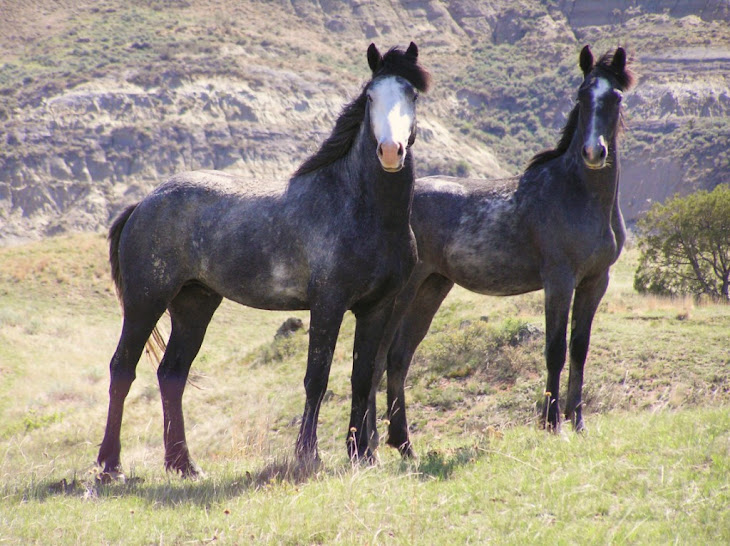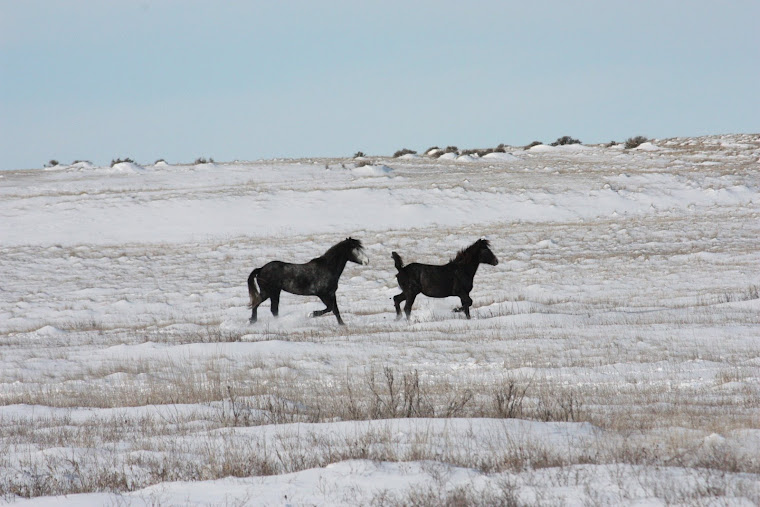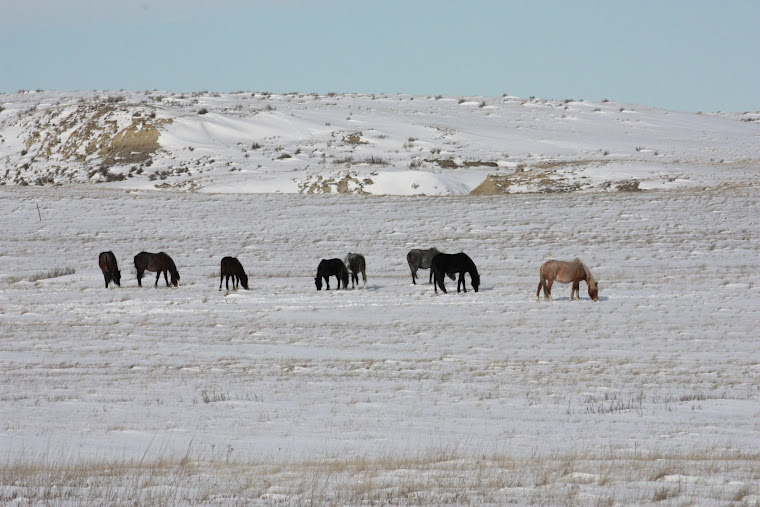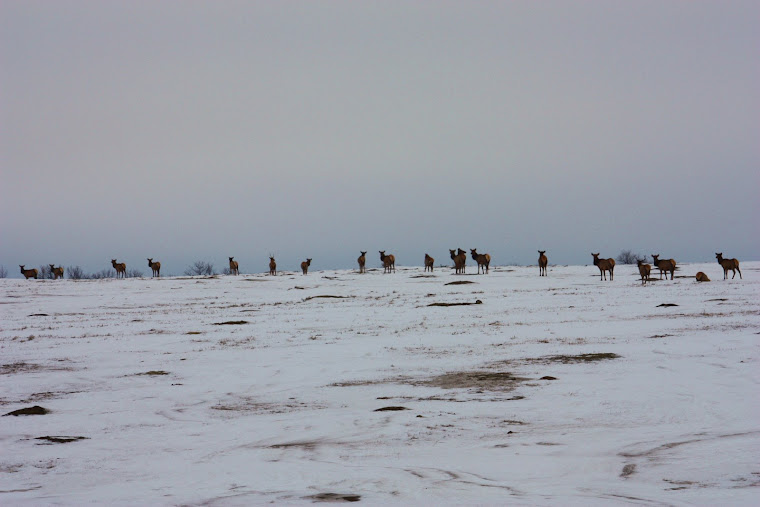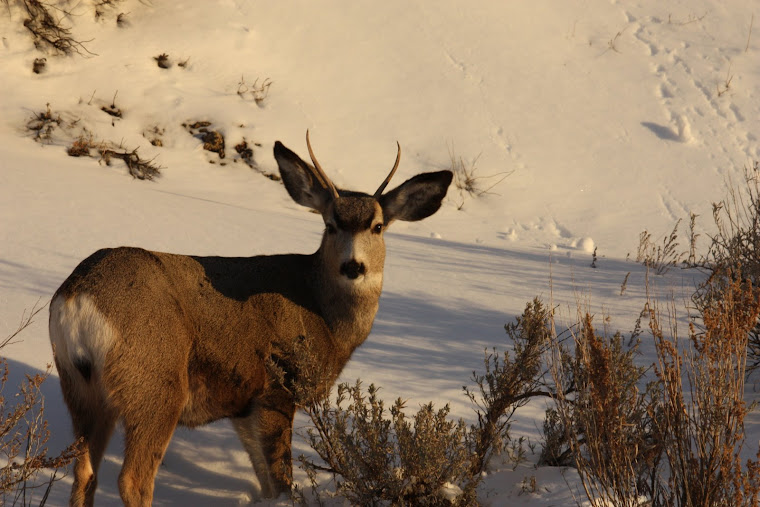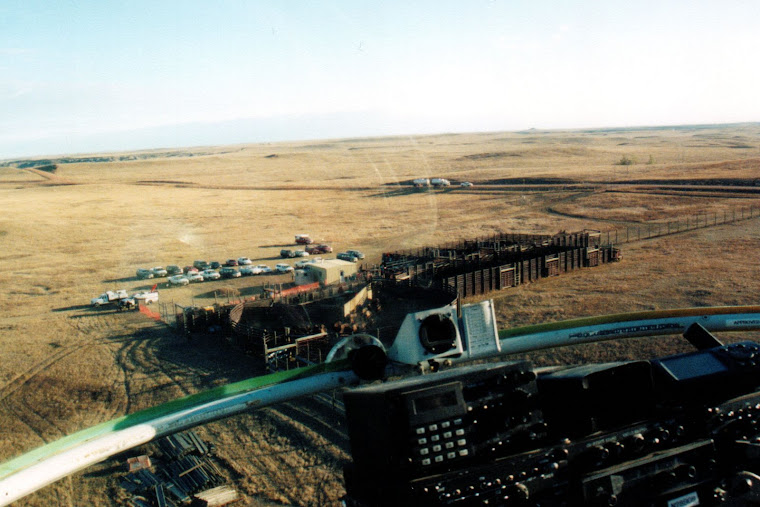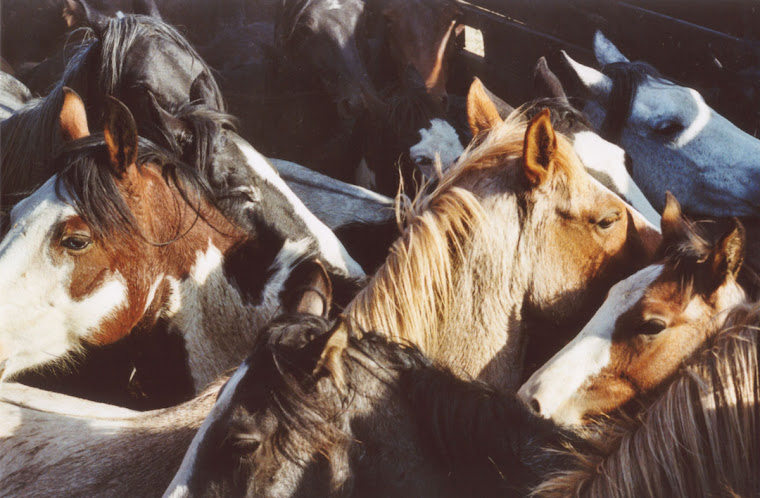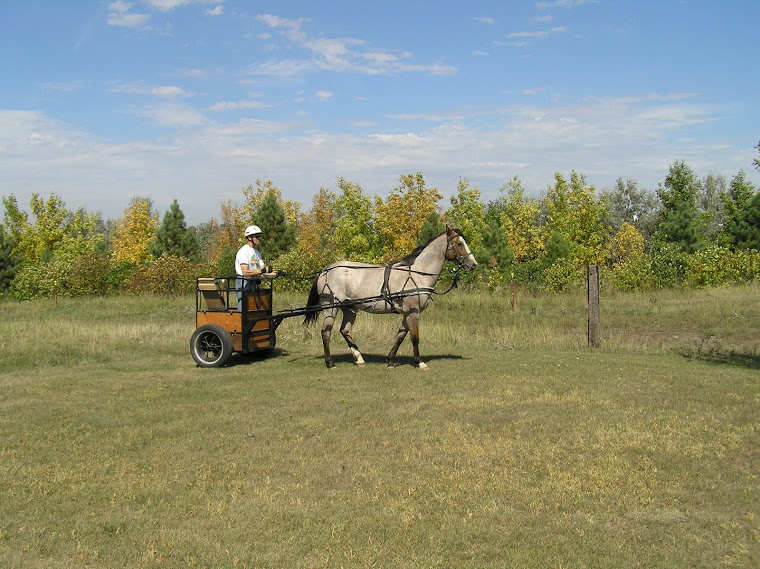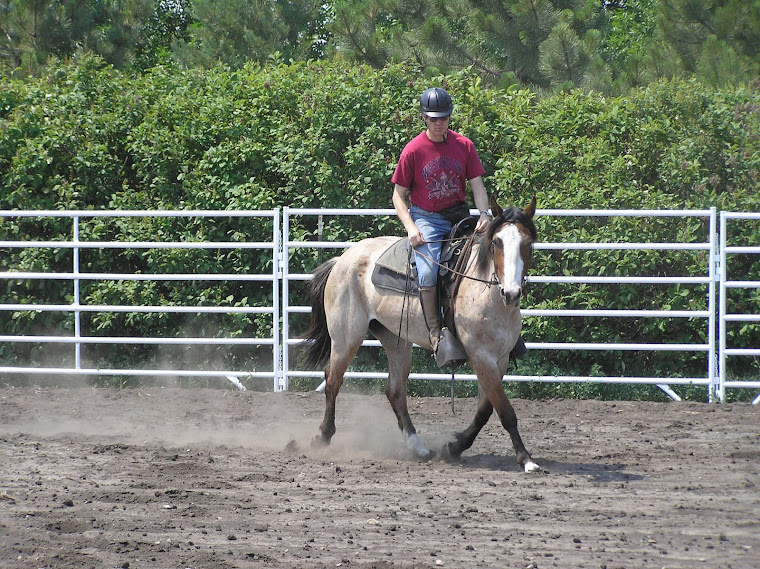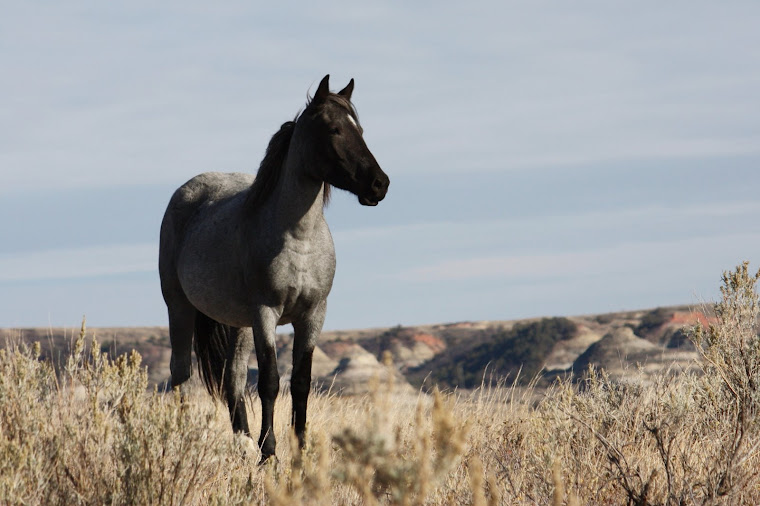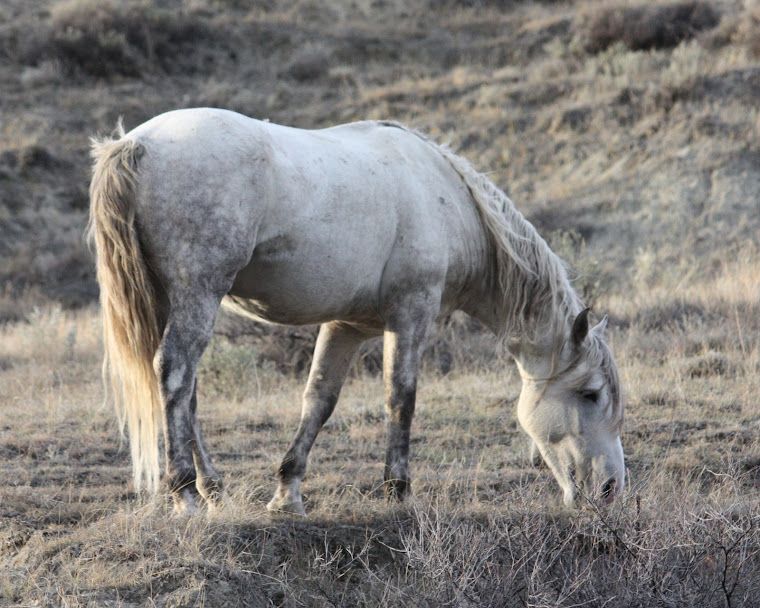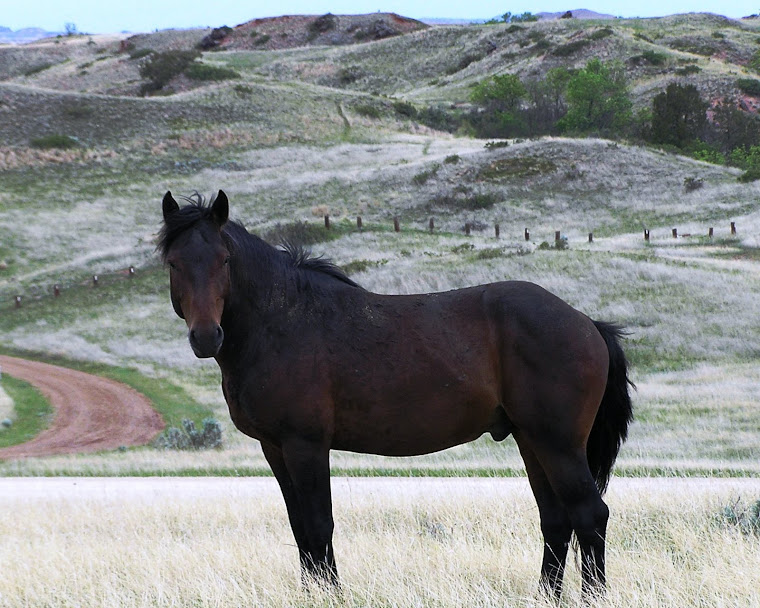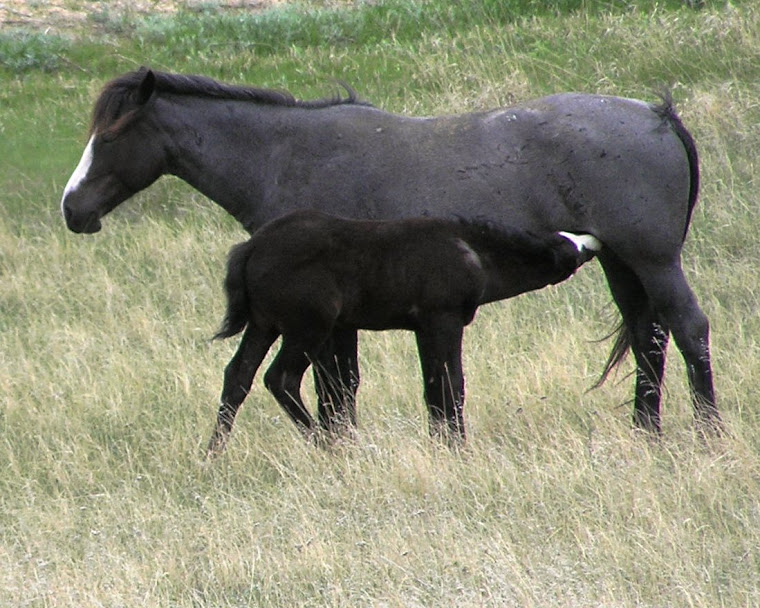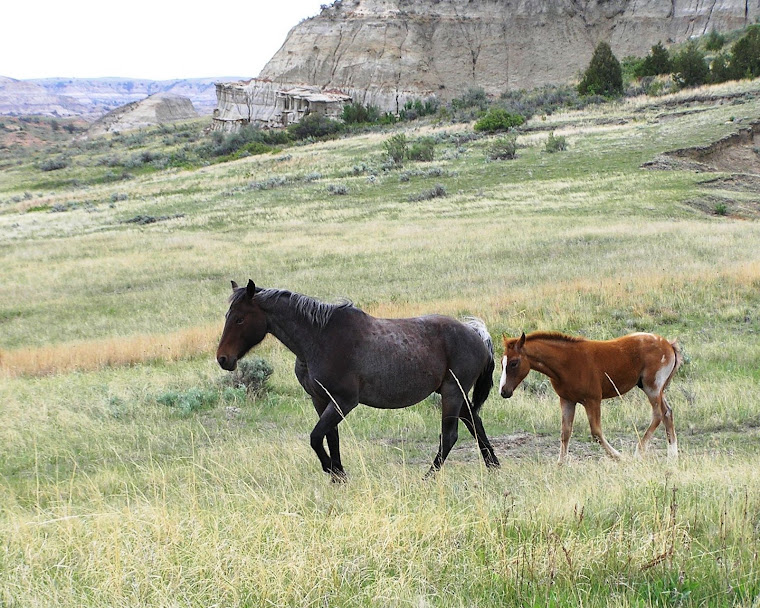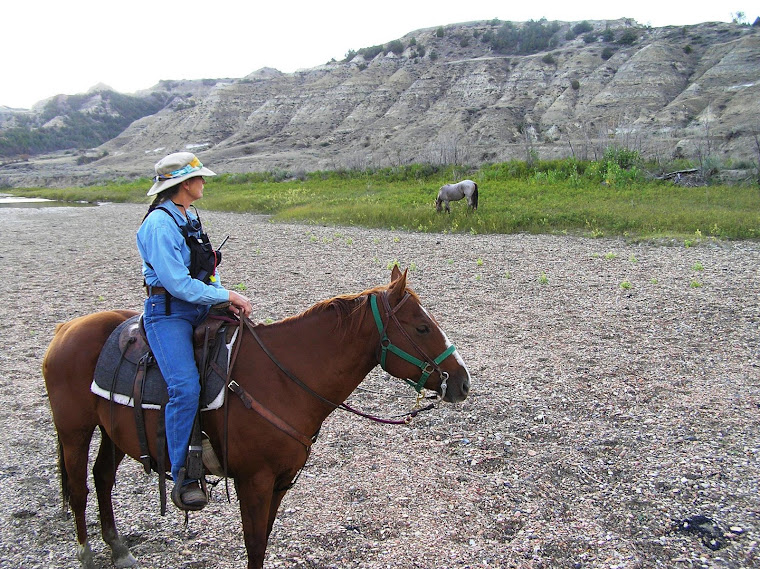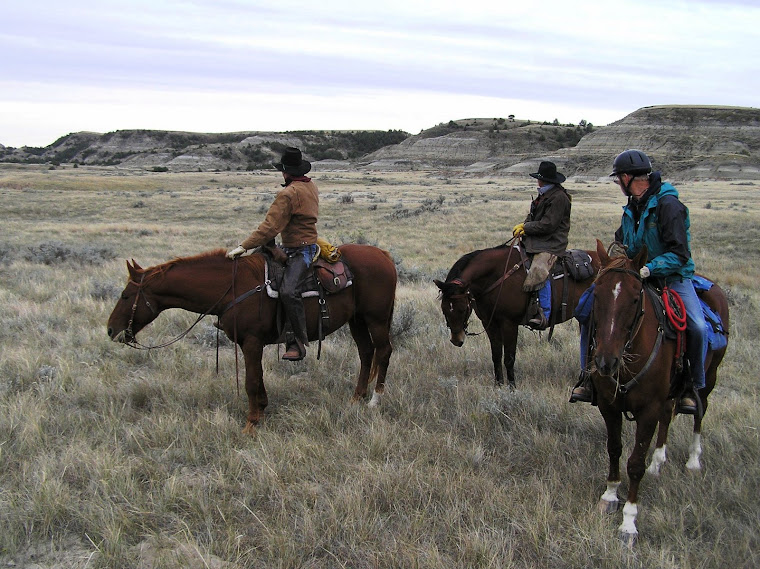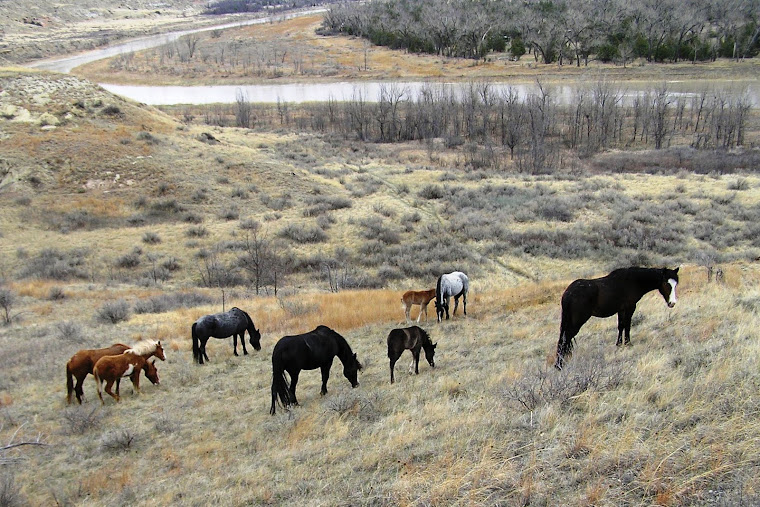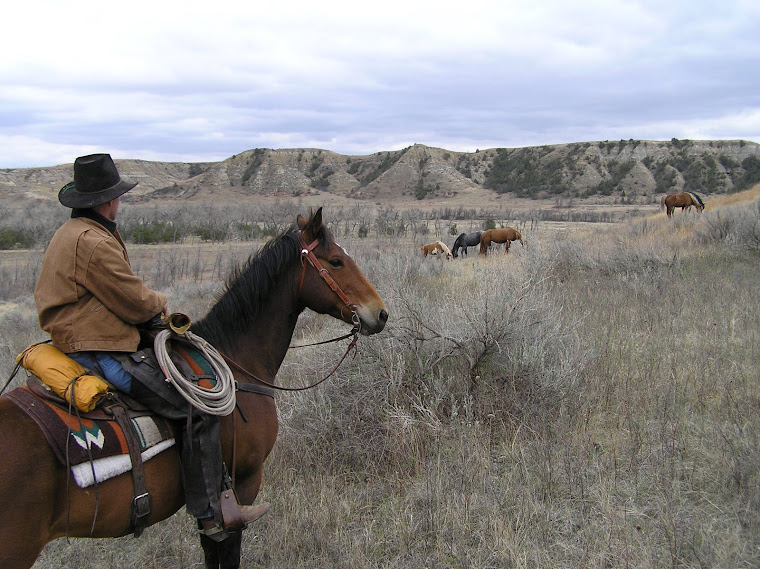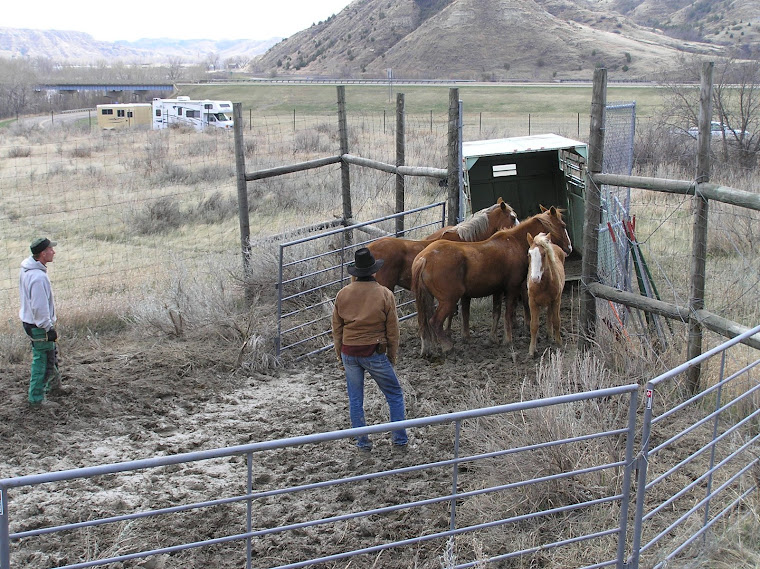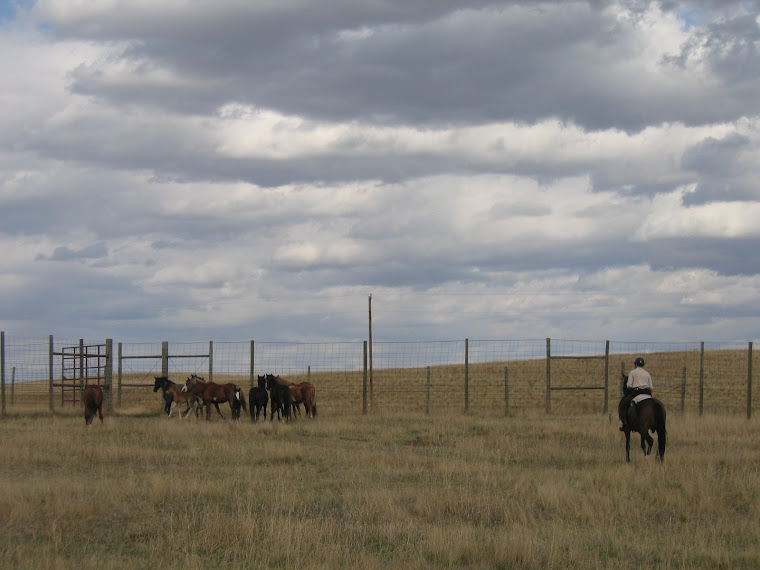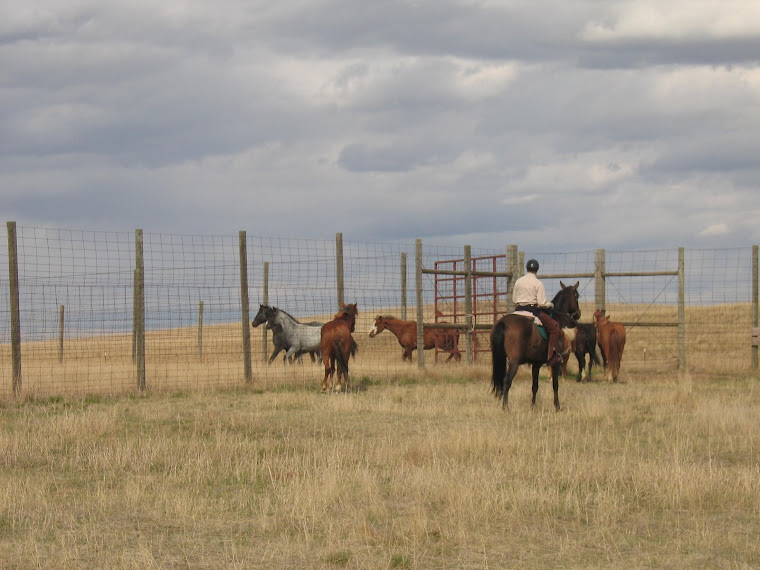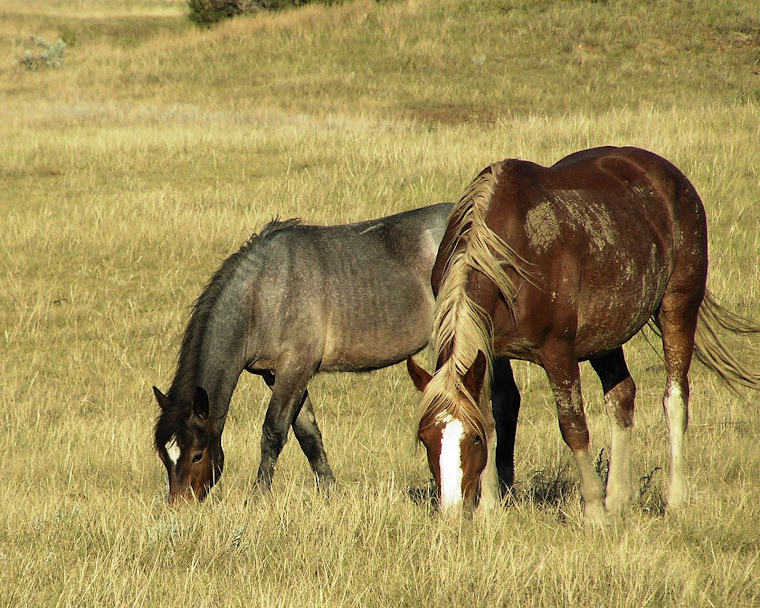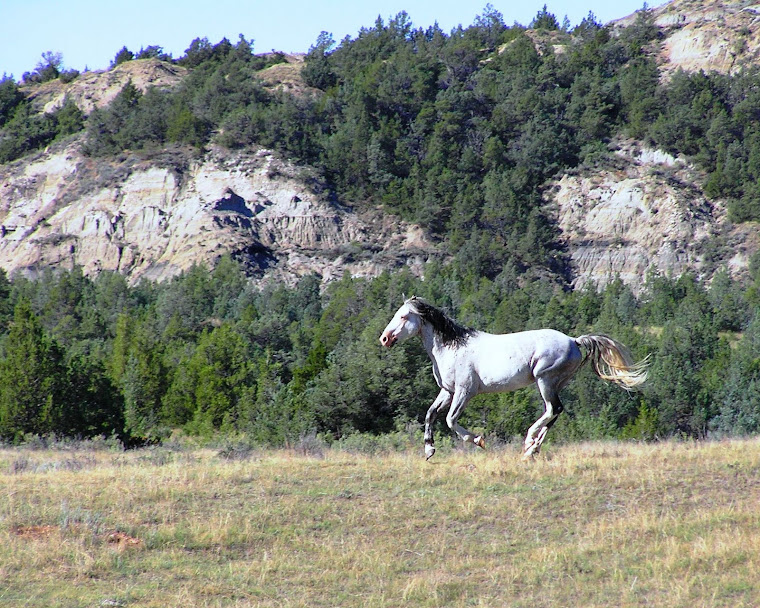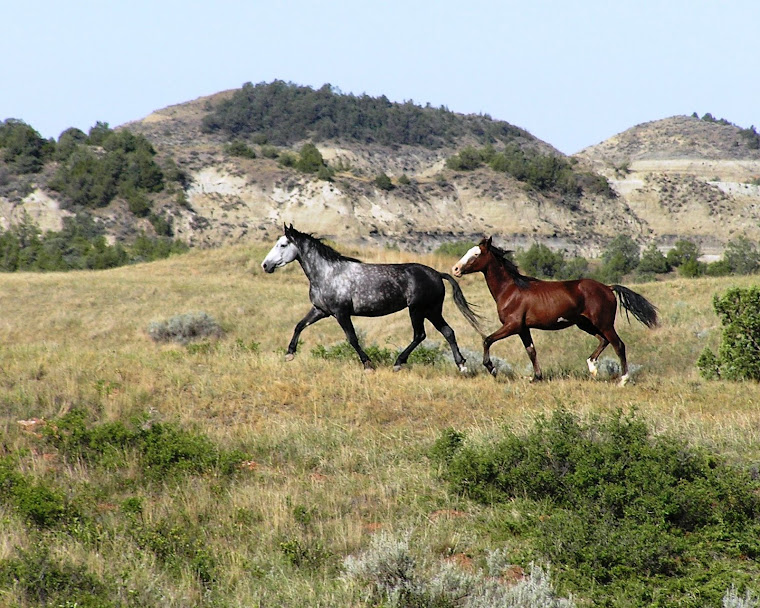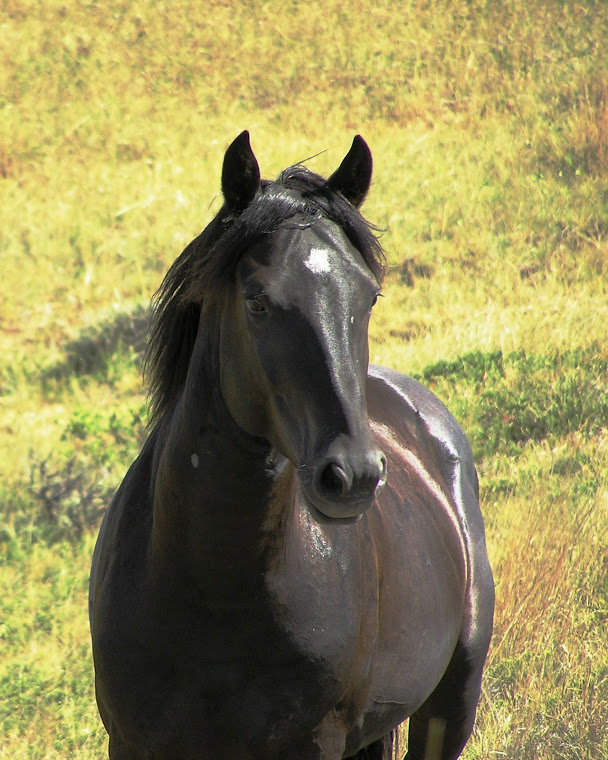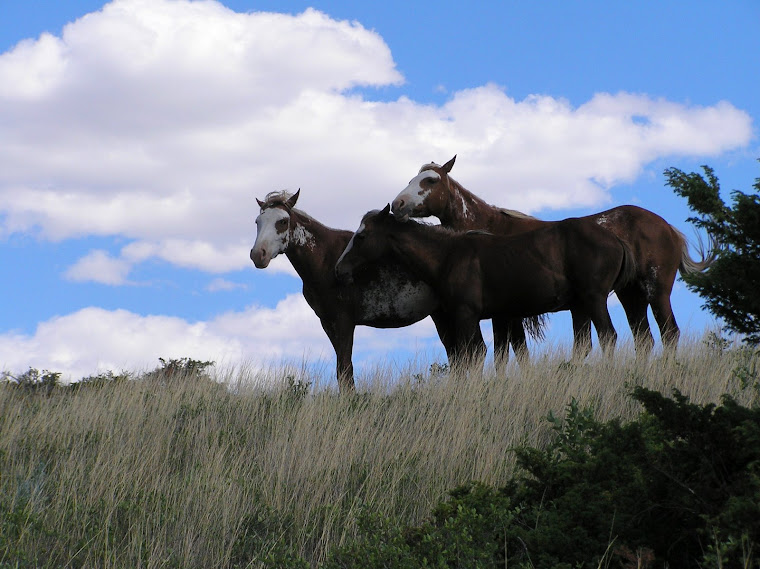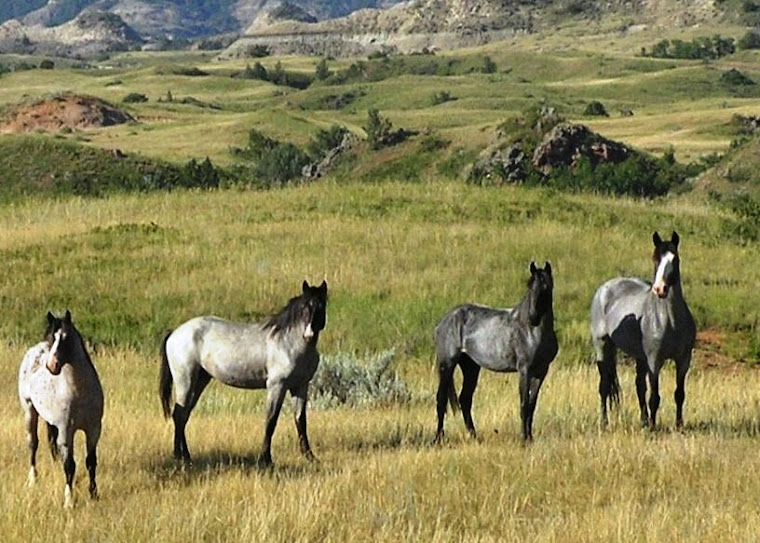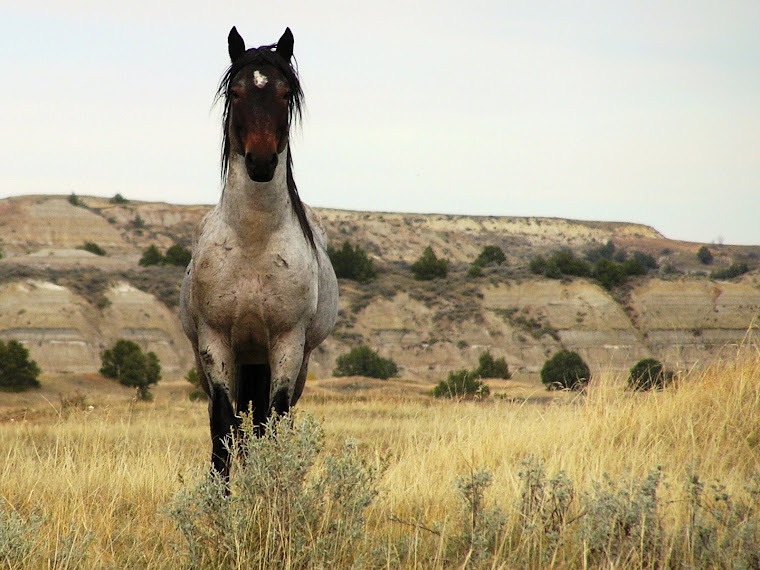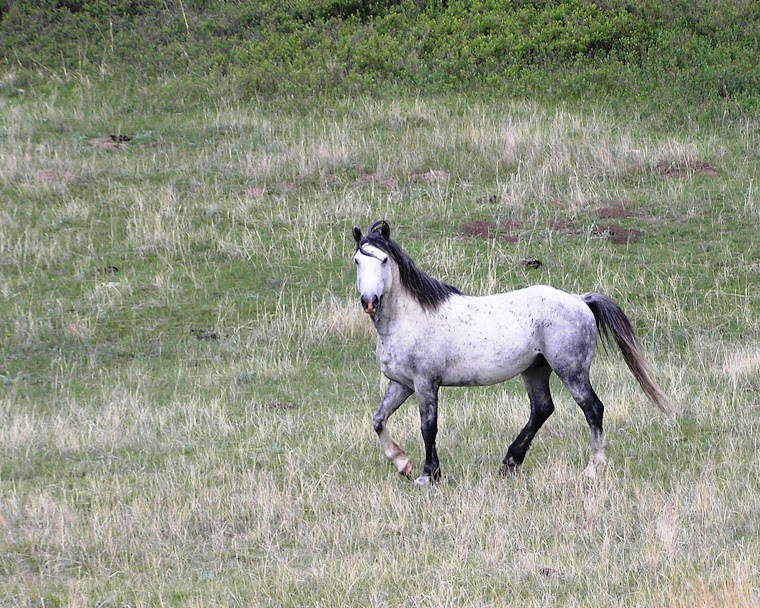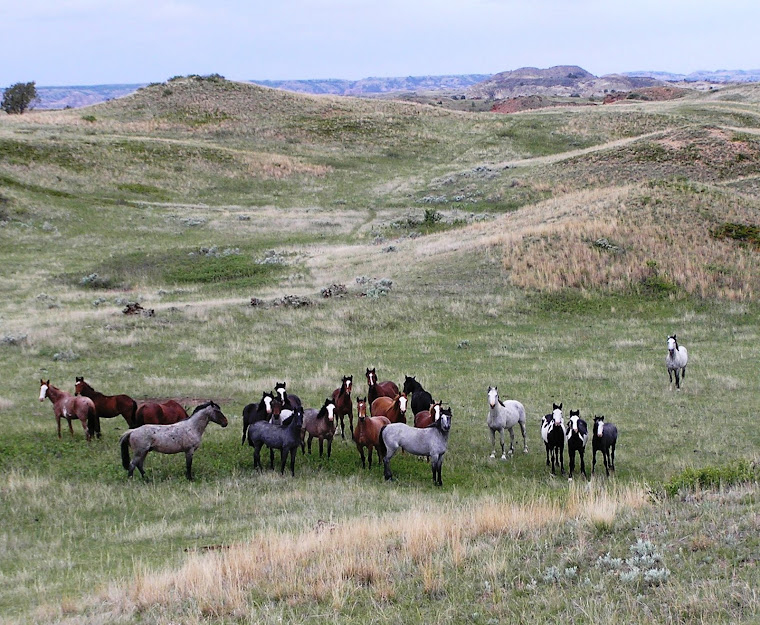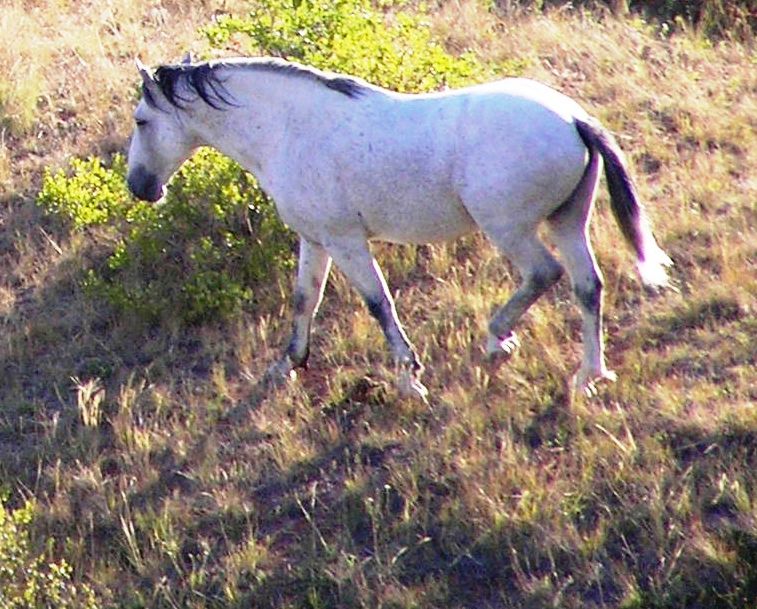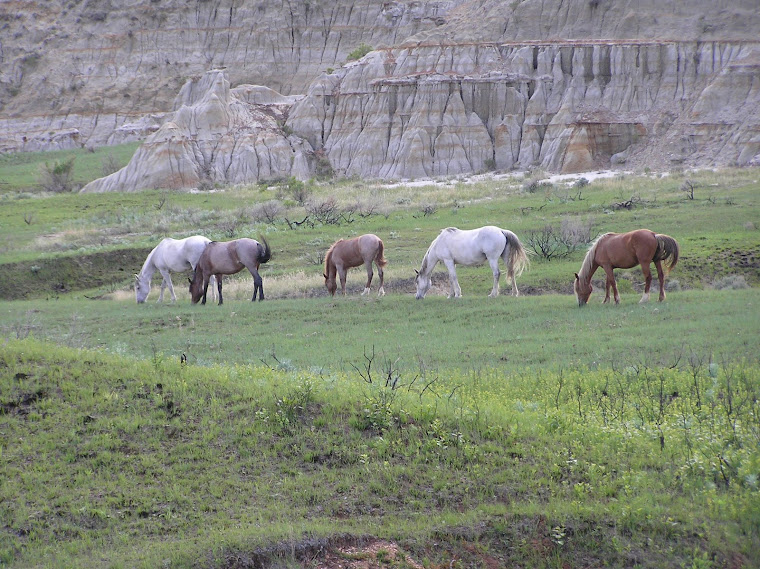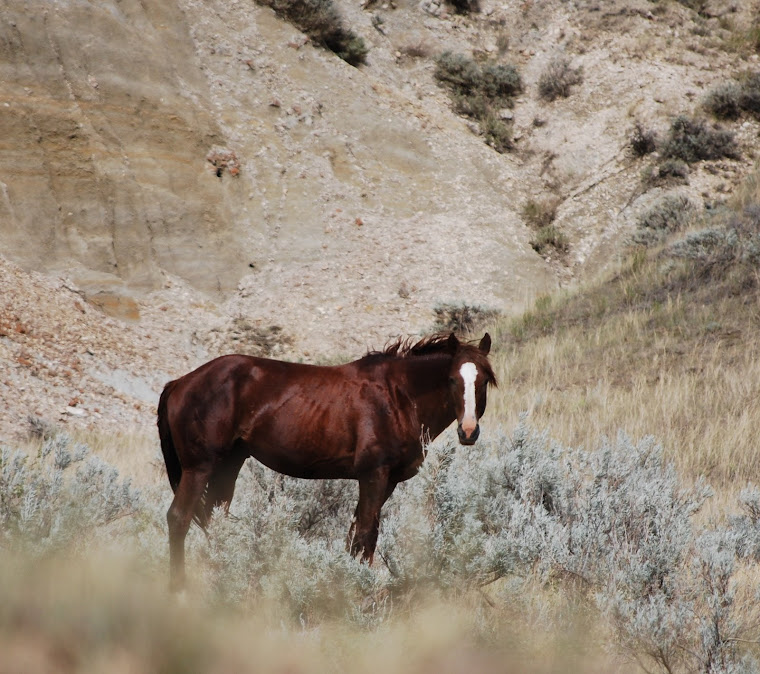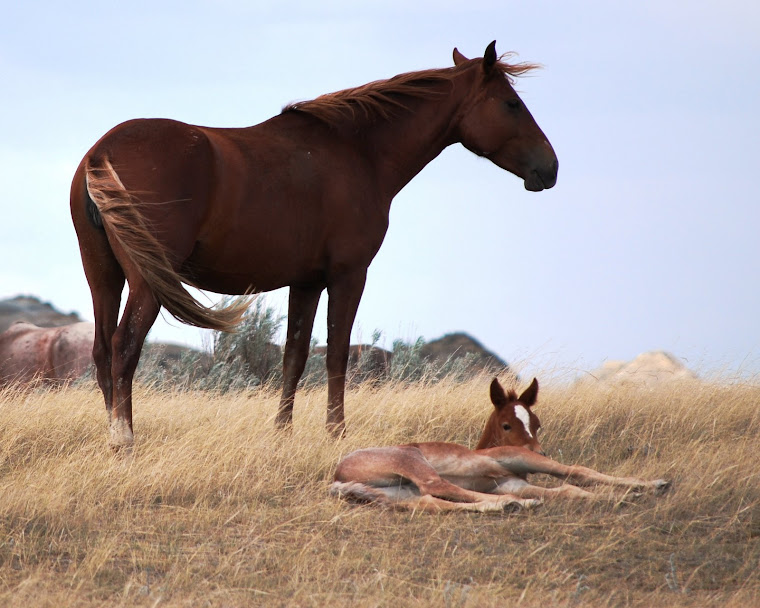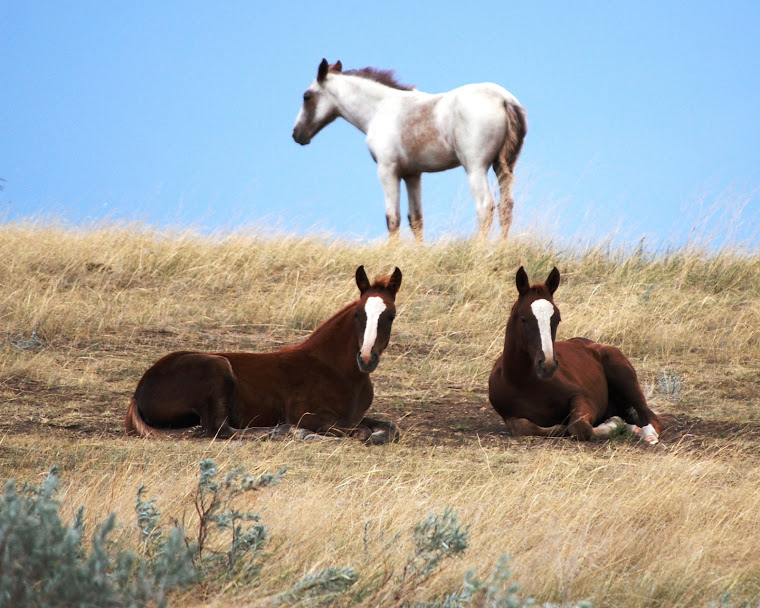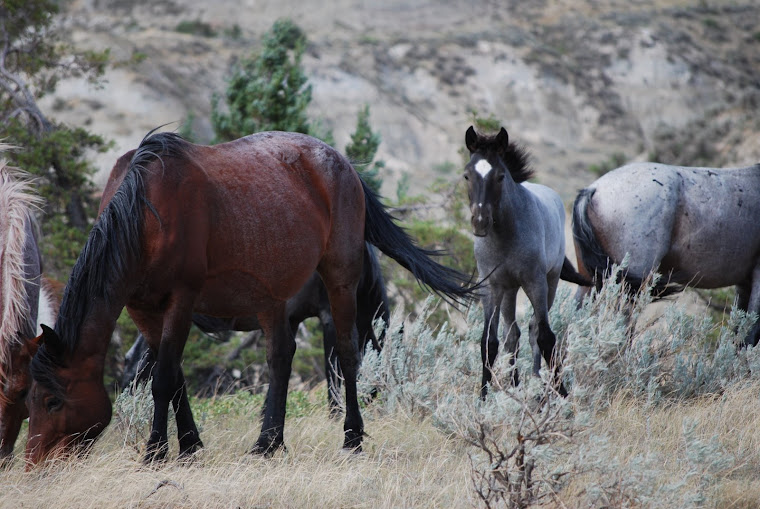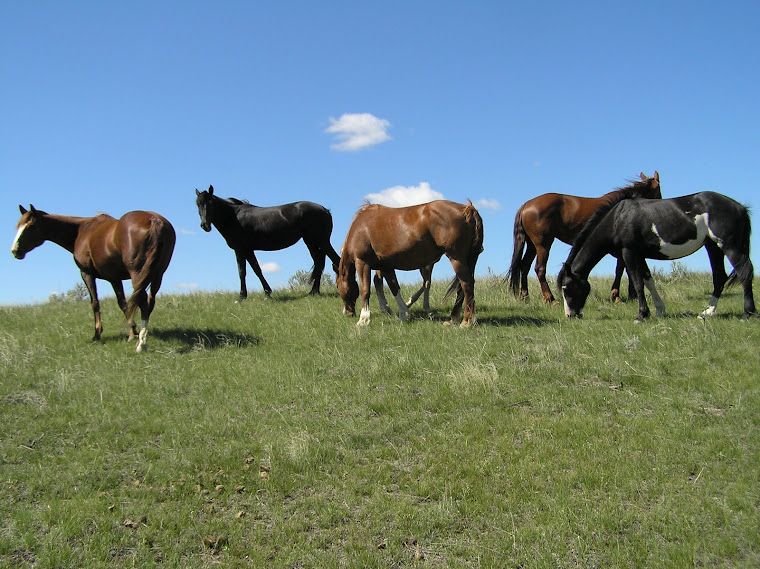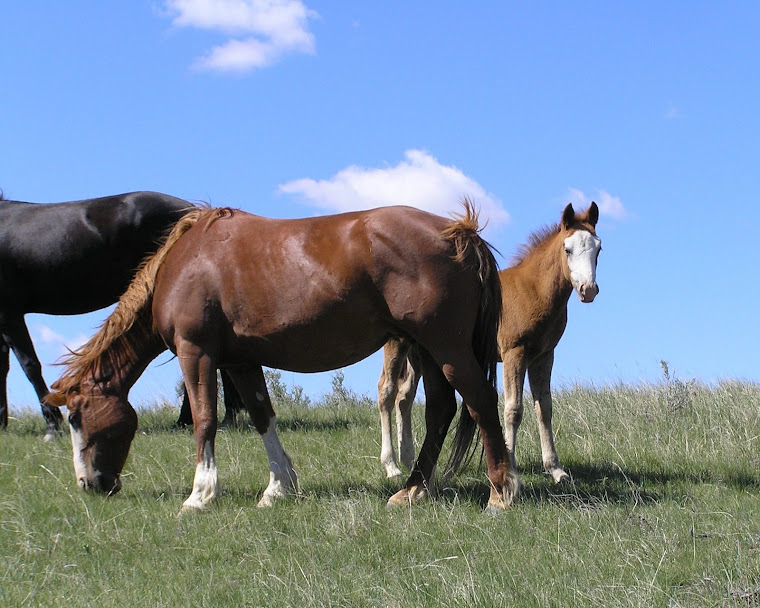I have lived a lot of years and trained a few horses, but none are more fascinating than the wild horses from the park. They are essentially blank slates with very little, if any, close up experience with humans. Oh, they've seen us in the park and had the unpleasant experience of being pushed though chutes, sales rings, trailers, and pens, so they have had some good and not so good experience with us, but horses are generally very forgiving and oh, so curious.
We've found that a year in the life of one of these horses makes a lot of difference. Most of us who have weanlings are petting them and getting them to trust us. Some owners report having their babies halter broken already. A lot depends on the temperament of the individual and the amount of time one is able to spend with the little newcomer.
A weanling is always very curious, but also frightened of these two legged predators who have captured him and seemed bent on putting their paws on him. Working a baby is much different from working an older horse. One does not want to push him very fast or very long, as he can injure his delicate legs. I recommend John Lyons' book, Bringing Up Baby. It gives step-by-step lessons for training a foal in it's first year without injury to either the foal or the handler.
Our little Hail has been a joy to work with. He was, at first, very frightened, but careful, patient work in the round pen soon paid off. First teaching him that I was dominant yet trustworthy, I was able to get him to walk, turn, stop, face me, and eventually let me touch him. At first it was less frightening to touch with a training stick, but that led to being able to scratch and pet him with a hand. He now lets me touch him all over from both sides. It is very important to train both sides. Little Hail now comes to me for his scratches, as he has learned that the two legs can be pretty good friends. Recently, I was working with Griggs, the other weanling we are keeping; I had put Hail in a smaller round pen to wait his turn to "play." It soon became clear to me that Hail wasn't being so patient for his scratching. He was running around the little pen bucking and kicking alternately with pawing at the fence between us and trying to stick his head through it. Once I let Griggs out of the big pen and opened the gate to Hail's pen, he went right in and waited for his scratches!
As much fun as the little guys are, they do not compare with the older ones. Hawk, our yearling, has taught me so much in the few weeks we have had him. I feel so privileged to have this exquisite wild creature in my barnyard. I literally can't wait to get to work with him every day and I think he is beginning the enjoy our sessions as much as I do.
The extra year in his life had made him more convinced that this predator was out to get him. At first he jumped and ran to the other side of the pen every time he saw us or heard our footsteps in the gravel. The first couple weeks were spent just getting him used to having people around him. We would sit near his pen and near his feed, walk around on the outside of the pen, and finally clean it with him in it.
He was so frightened of me every time I walked into the pen that I had to try something else. My friend had said to put a gentle horse in with him so that he could take his cues from that horse. I tried working a gentle horse in the same pen, but that really freaked him out, so I had to think of some better plan that would help him relax. Finally, I hopped on my big, gentle dressage horse with no saddle or bridle and road him around in the round pen with Hawk. Maestro was so relaxed that Hawk soon accepted him and me on his back. I was able to work the youngster around the pen, pushing him when he ran from us and stopping and taking the pressure off him when he stopped. The pen was a little too small to get him to face us, so I just took advantage of the stopping and standing. I used the training stick to get him used to having me moving around on the other horse. Before long, I was able to swing the stick around, up and down and slap it's string against the ground and the rails. With rhythmic movements, I could make it approach and retreat from him until I could finally touch him and scratch him with it. Maestro's ability to side pass made it easy to slide up to Hawk without frightening him. Within a week of taking Maestro into the pen, I was able to go through the ritual of moving him, stopping him, snapping the whip around, touching him with it and ending with scratching him with my hand. A couple weeks of this along with cleaning his pen twice a day helped Hawk adjust to having me closer to him, so it was time to try it on foot again.
The minute I would walk into his pen without the wheel barrow, he would began to circle the pen with his head in the air. That was good, because one of the first things I wanted to teach him was that I could make him move his feet. He soon learned that I could move his feet at any speed, in any direction. I had to speak his language to get him to understand what I wanted him to do. As I learned his response to body language, he learned what I was asking of him. I could just lift an hand to make him move, walking in a small circle with him, focusing my energy on his hip. Stopping my energy while stepping back a bit would stop him. Pointing in the other direction would send him off again in that direction. When I rewarded him each time he turned to the inside by turning away from him, he learned that I wanted him to face me.
That was when the dance became even more fun. He learned that he was to face me wherever I went in his pen. If I stared at his hind feet from one side, he would move them to the other. Soon by moving his hind feet I could get him to move his front feet. Taking a step forward earned him a big reward of having me turn away, taking all the pressure off of him. The closer he got to me, the more curious he became. Touching the end of the training stick was a huge step for him. I always made sure to stop the lesson on a positive note when he had made a move to trust and before he lost his confidence.
In the dance, it is so very important to know when to step forward and when to step back. One must know ones partner and what he is thinking in order to step back, taking the pressure off just before he wants to run. Rhythm in the approach and retreat builds the horse's confidence as he begins to sense the predictable nature of the dance. Moving, stopping, turning, coming forward, backing up, touch, release, reward, these were the things Hawk already knew from his band in the wild and he was learning that I could be his leader in his new world.
Now he too looks forward to his "play" in the round pen. He readily leaves his little buddies and goes to the round pen, immediately interested in what will happen this time. I move him around to establish the fact that I am leading this dance. I invite him in and he acknowledges me by touching my hand. I remove the hand before he removes his nose and rhythmically stroke his shoulders with the training stick. I stop. He bobs his head as if to say, "I like this dance; let's do it again." We repeat the dance getting closer and closer until I can brush him with my hand. then I walk away before he does. He comes again, forward and back, in and out, all the while we look into one another's eyes. I wonder at the sun shining through his blue eye and the softness and vulnerability I see in his brown one; he looks to me hoping he can trust me, but still not sure, so the dance continues. I hope it never ends.
Monday, December 14, 2009
Monday, November 30, 2009
Monday, November 9, 2009
OUR BOYS COME HOME
Tracking the horses in a roundup year is difficult when you don't plan to buy any at the sale, but this year was particularly emotional knowing we did plan to take some home. I didn't want to get attached to any one for fear the youngster may not make it until fall with all the perils in the park. Then there was the worry that they might be injured during the roundup or at the sales barn. I tried to keep an open mind, not deciding on any particular horses until I knew they were safe, but it didn't work. We had decided we could take as many as four if need be, but would definitely want as least two so that we would each have a backup for the horses we ride for the tracking.
By mid-summer I had a few favorites. The first to snuggle his way into my heart was Marquis. I had always loved his sire, High Star, and his dam, Pale Lady. Little Marquis was just too cute with his wispy soft dun color and noble blaze. He was well built and fine featured like his sire and though not representative of the characteristic colors of the park, I could see him fitting in just fine in our pasture. In order to keep him company he needed a brother from the same band. His full brother, Sage, had always been a favorite of mine, but I didn't think we had the skills to deal with a two year old stallion. The yearling, Hawk, had caught my eye as well. Yearlings are notoriously homely and Hawk was no exception, but he had an unusual bay roan coat, the characteristic bald face, and a flashing blue eye. He's the kind of color people either love or hate; I grew to love him.
I had always thought I would like to have a foal from Thunder's band. He is powerful, one of the larger stallions in the park, short coupled, and nicely balanced. He had two nice colts from last year, but we already had a yearling on the wish list, so wondered what he might have this year. His is one of the most illusive bands, claiming their territory on the bottoms west of the far eastern rim, but finally, at the end of June, we saw the band from Buck Hill and watched them with the scope as they climbed the butte onto the flats on the east side of the park. Could we get there to see them before dark? We had to try since we could make out the form of a very small foal with them. We got to the east side just as the sun was setting, but it was light enough to see the band and get a few shots as they swirled around us in the near darkness. There was the foal with Rain, a tiny dark colt with a large round star perfectly placed in the middle of his forehead. Henry and I had been caught in a rain storm and hailed on the day before. The colt's sire was Thunder Cloud and his dam was Rain; he had to be Hail!
We didn't see Hail again until the end of September. Fortunately for us, they were on Lindbo Flats with dozens of others. Again is was nearing sunset, but it was unseasonably warm and quiet. Red Face and Singlefoot were off to the east, but Blaze and several bachelors were near the fence where we slid under to get a better look. Thunder eyed us cautiously from a small butte a few hundred yards to the south as we enjoyed the antics of the bachelors. Finally, determining we we no threat to him and his family, Thunder paraded them right to us. We watched as he sparred with a couple bachelors with his son, Clipper, closely following him. I marveled at the chance to see Thunder so close, and along with him, little Hail, three months old and stunningly beautiful! His dark coat had turned to blue, just like his daddy's and his legs were long and strait. He went to the top of the list with Marquis.
With Blaze was little Talkington, also a handsome blue roan. He would be smaller than Hail, but a good match for color. The thought of a team of blues crossed my mind. I also loved little Griggs from Red Face's band. He was an adorable bay roan with an engaging temperament. When High Star unexpectedly disappeared, my thoughts went back to his band and little Barnhart, another blue roan with a tiny star. I would have to see them come in and make my final decisions then.
At the roundup, we were successful in bringing in all the mares and foals; that is, all but Pale Lady and Marquis. Pale Lady slipped away from the choppers when they brought in the rest of her band. Though they were just south of the handling facility when the last run was made, it was too rainy to see them and they were missed again. It was meant to be that Marquis would stay in the park. One day he will be a strong band sire like his father and brother.
All the others came in safe and strong. Since there were so many people coming to buy, we decided to buy two or three. Hail, Hawk, and Talkington were on the list. My friends were there to support us and had agreed to bid for me, since I was to be up in the box with the auctioneers, still IDing horses. At first I told Joan to buy them for whatever it took. It didn't take long to realize I was being foolish; I had Henry give her a limit. The foals were first and bringing unbelievable prices. I swallowed hard as Hail entered the ring. Joan bid like a pro. I could just see her over the head of one of the auctioneers. The bidding was lively and the price crept up. It was up to my limit; I nodded to Joan to keep bidding. Crazy or not, I wanted that colt. Joan made another bid with my nod; the auctioneer went on and on begging for another bid. Enough, enough, I cried to myself as he seemed to try too hard to outbid me, but Joan had prevailed and Hail was mine! Takington was next; I had fallen in love with the little tyke when he stood so quietly to have his blood drawn for the Coggins test. Again the price crept up and up. I knew Hawk was waiting with the other yearlings. I really wanted him too. I finally let Talkington go. I didn't know who was bidding at the time, but found out later that a very nice lady from MN had bought him and would give him a wonderful home.
Hawk was next. For all his wild looks, he was handsome and proud. Though he was extremely frightened, he kept his cool in that noisy foreign place. Joan was watching as the bidding started, but didn't want to seem too eager, so hung back a bit. My other friend jabbed her in the ribs with an elbow, thinking she was preoccupied and missing out on the colt. Joan nonchalantly lifted her number. Up and up the bid climbed, but stopped below my limit. The other colt I wanted so badly was mine. Now I could relax.
Now with only two boys, I could take my time with them and spend more time with Whisper, the filly. I would not feel the pressure to sell her too soon. As it turned out, we are keeping sweet little Griggs for a friend, so he is Hail's new buddy. The training will be fun!
By mid-summer I had a few favorites. The first to snuggle his way into my heart was Marquis. I had always loved his sire, High Star, and his dam, Pale Lady. Little Marquis was just too cute with his wispy soft dun color and noble blaze. He was well built and fine featured like his sire and though not representative of the characteristic colors of the park, I could see him fitting in just fine in our pasture. In order to keep him company he needed a brother from the same band. His full brother, Sage, had always been a favorite of mine, but I didn't think we had the skills to deal with a two year old stallion. The yearling, Hawk, had caught my eye as well. Yearlings are notoriously homely and Hawk was no exception, but he had an unusual bay roan coat, the characteristic bald face, and a flashing blue eye. He's the kind of color people either love or hate; I grew to love him.
I had always thought I would like to have a foal from Thunder's band. He is powerful, one of the larger stallions in the park, short coupled, and nicely balanced. He had two nice colts from last year, but we already had a yearling on the wish list, so wondered what he might have this year. His is one of the most illusive bands, claiming their territory on the bottoms west of the far eastern rim, but finally, at the end of June, we saw the band from Buck Hill and watched them with the scope as they climbed the butte onto the flats on the east side of the park. Could we get there to see them before dark? We had to try since we could make out the form of a very small foal with them. We got to the east side just as the sun was setting, but it was light enough to see the band and get a few shots as they swirled around us in the near darkness. There was the foal with Rain, a tiny dark colt with a large round star perfectly placed in the middle of his forehead. Henry and I had been caught in a rain storm and hailed on the day before. The colt's sire was Thunder Cloud and his dam was Rain; he had to be Hail!
We didn't see Hail again until the end of September. Fortunately for us, they were on Lindbo Flats with dozens of others. Again is was nearing sunset, but it was unseasonably warm and quiet. Red Face and Singlefoot were off to the east, but Blaze and several bachelors were near the fence where we slid under to get a better look. Thunder eyed us cautiously from a small butte a few hundred yards to the south as we enjoyed the antics of the bachelors. Finally, determining we we no threat to him and his family, Thunder paraded them right to us. We watched as he sparred with a couple bachelors with his son, Clipper, closely following him. I marveled at the chance to see Thunder so close, and along with him, little Hail, three months old and stunningly beautiful! His dark coat had turned to blue, just like his daddy's and his legs were long and strait. He went to the top of the list with Marquis.
With Blaze was little Talkington, also a handsome blue roan. He would be smaller than Hail, but a good match for color. The thought of a team of blues crossed my mind. I also loved little Griggs from Red Face's band. He was an adorable bay roan with an engaging temperament. When High Star unexpectedly disappeared, my thoughts went back to his band and little Barnhart, another blue roan with a tiny star. I would have to see them come in and make my final decisions then.
At the roundup, we were successful in bringing in all the mares and foals; that is, all but Pale Lady and Marquis. Pale Lady slipped away from the choppers when they brought in the rest of her band. Though they were just south of the handling facility when the last run was made, it was too rainy to see them and they were missed again. It was meant to be that Marquis would stay in the park. One day he will be a strong band sire like his father and brother.
All the others came in safe and strong. Since there were so many people coming to buy, we decided to buy two or three. Hail, Hawk, and Talkington were on the list. My friends were there to support us and had agreed to bid for me, since I was to be up in the box with the auctioneers, still IDing horses. At first I told Joan to buy them for whatever it took. It didn't take long to realize I was being foolish; I had Henry give her a limit. The foals were first and bringing unbelievable prices. I swallowed hard as Hail entered the ring. Joan bid like a pro. I could just see her over the head of one of the auctioneers. The bidding was lively and the price crept up. It was up to my limit; I nodded to Joan to keep bidding. Crazy or not, I wanted that colt. Joan made another bid with my nod; the auctioneer went on and on begging for another bid. Enough, enough, I cried to myself as he seemed to try too hard to outbid me, but Joan had prevailed and Hail was mine! Takington was next; I had fallen in love with the little tyke when he stood so quietly to have his blood drawn for the Coggins test. Again the price crept up and up. I knew Hawk was waiting with the other yearlings. I really wanted him too. I finally let Talkington go. I didn't know who was bidding at the time, but found out later that a very nice lady from MN had bought him and would give him a wonderful home.
Hawk was next. For all his wild looks, he was handsome and proud. Though he was extremely frightened, he kept his cool in that noisy foreign place. Joan was watching as the bidding started, but didn't want to seem too eager, so hung back a bit. My other friend jabbed her in the ribs with an elbow, thinking she was preoccupied and missing out on the colt. Joan nonchalantly lifted her number. Up and up the bid climbed, but stopped below my limit. The other colt I wanted so badly was mine. Now I could relax.
Now with only two boys, I could take my time with them and spend more time with Whisper, the filly. I would not feel the pressure to sell her too soon. As it turned out, we are keeping sweet little Griggs for a friend, so he is Hail's new buddy. The training will be fun!
Wednesday, November 4, 2009
THE SALE, 2009
The adrenalin rush of the roundup was over and relief washed over us as we looked back on a very safe, successful roundup. Now it was time to concentrate on those animals who would be hauled to the sales barn in Dickinson and sold to the highest bidder. My friends and I had worked tirelessly to get the word out about these beautiful wild horses. I had been hearing from a lot of prospective buyers, and it seemed as if we were going to have a good crowd at the sales barn Friday, so there was nothing more we could do now but wait.
This sale would be different from those in the past. Now all the horses had names and those names would be the way the buyers who had seen our fliers, articles, and photos would know them. Thursday afternoon we were lucky enough to watch the horses come in and be unloaded. I prayed none of them would be injured here at this strange place. They all seemed to settle in very easily and were not alarmed as a few early arrivals tried to figure out which one matched the names they had picked out. By the next morning more people were pouring into the parking lot. Mike had filled in all the hip tag numbers with the appropriate horses and brought the sale lists that morning. Excited potential buyers moved from pen to pen spotting their favorites and discussing each one's potential in hushed tones. Some buyers were on the phone describing horses for others who could not be at the sale, but wanted to buy. Most of our group headed into the auction area early to get good seats. I would be up in the auctioneer's box so that I could identify those whose hip tags were either missing or too crumpled to read, so I had a little time to get my head together. Then the bidding began.
There were a few domestics sold first. Prices were low; a nice Quarter Horse foal went for $7.50. Then, the first TRNP foal came into the ring. It was Sheila, the pretty filly from Blaze and Little Brother's Girl. The bidding began, and as amazed murmurs rippled through the crowd, the bidding continued, bringing a respectable amount for the chestnut filly. As each weanling appeared, the bidding picked up. The auctioneers burst into giddy grins as the auction took on a festive nature. Cheers broke out as buyers won the baby they had hoped to buy. Badlands Bill, the beautiful red dun with a bald face and four high stockings, that I had predicted would bring the highest price, was finally won by our good friends for $1450. Several other foals brought very good prices with the weanlings averaging $361. The yearlings, lanky and thin, struggling to grow into their limbs, also sold very well, averaging over $200 each. The handsome blue roan, Full Moon, brought $575 from some more good friends from MN.
Two and three year old studs came next and experienced horsemen vied for the chance to gentle a young stallion, born in the wild and already testing his power among the bachelor bands. They too were going well until the blue gray two year old, Bashful, ran timidly into the ring. At first he froze when bombarded with all the light and noise in the auction ring. Another friend from ND had the bid and they were about to let him out, when a ring man pressured him too much. He stood to his hind legs and easily launched himself over the 6 foot, double ring fence into the seating; only his right hind leg hanging up on the fence prevented him from running headlong through the scattering crowd! Screams irrupted as frightened onlookers ran from the building. A quick thinking horseman jumped into the ring and wrapped the frightened horse's tail around the ring rail and another tied the hind leg to the rail with his own belt.
An older gentleman with a walker had been unlucky enough to be right in front of the horse when he cleared the fence with his entire front end. The man was under the frightened stallion as it pawed to be free of the biting fence. The man's wife and a brave cameraman were able to drag him to safety before he was mortally injured. Once the man was safely outside along with the majority of the crowd, the sales barn staff was able to deal with the horse, who was thrashing and raging at anything he could reach. A man's jacket, the chair the old man had been sitting on, anything he could get his teeth into was a target of the hurting stallion's wrath, since he could no longer run from his pain. Miraculously the men were able to sedate him, remove him from the fence, and walk him down the stairs and out the door to the freedom of a quieter place! He stood quietly, lost in the fog of the sedative, but relieved to be rid of the noise and the monster that had held his leg.
People milled around outside on the warm, sunny day, shaken and not sure what to do next. An ambulance came to take the injured, but alert man to the hospital. Thoughts of fresh ownership of horses were momentarily forgotten while prayers were said for the man and the horse. When both had been dealt with in a proper manner, the owner announced that the rest of the horses would be sold in the pens inside the barn where they had been waiting to enter the ring. Though it was announced that only buyers were to enter the barn, the alleyway was soon filled with the curious along with the serious buyers. Unfortunately, the young stallion's behavior had frightened off all but a few tough trainers and some horse traders. Prices dropped to under $100 on the last few horses. I had a lump in my throat as I indentified those older horses for the auctioneer, not knowing what would be the fate of these unsuspecting animals.
All were soon sold except Bashful, the groggy, bloodied two year old who had just been pushed more than his young mind could handle. What was to happen to him? Earlier, just before the auction had resumed, a tall young man , the son of my dear friends, whom I had known since he rode his little black pony with us in the badlands, slipped in beside me and said in a determined voice, "I want that horse!" Just as quickly, he slipped away into the crowd and I lost sight of him, but when the bidding started for Bashful, there he was; he bought the frightened young stallion. Bashful was safe!
To follow his progress, go to: http://ahorsenamedbashful.blogspot.com
This sale would be different from those in the past. Now all the horses had names and those names would be the way the buyers who had seen our fliers, articles, and photos would know them. Thursday afternoon we were lucky enough to watch the horses come in and be unloaded. I prayed none of them would be injured here at this strange place. They all seemed to settle in very easily and were not alarmed as a few early arrivals tried to figure out which one matched the names they had picked out. By the next morning more people were pouring into the parking lot. Mike had filled in all the hip tag numbers with the appropriate horses and brought the sale lists that morning. Excited potential buyers moved from pen to pen spotting their favorites and discussing each one's potential in hushed tones. Some buyers were on the phone describing horses for others who could not be at the sale, but wanted to buy. Most of our group headed into the auction area early to get good seats. I would be up in the auctioneer's box so that I could identify those whose hip tags were either missing or too crumpled to read, so I had a little time to get my head together. Then the bidding began.
There were a few domestics sold first. Prices were low; a nice Quarter Horse foal went for $7.50. Then, the first TRNP foal came into the ring. It was Sheila, the pretty filly from Blaze and Little Brother's Girl. The bidding began, and as amazed murmurs rippled through the crowd, the bidding continued, bringing a respectable amount for the chestnut filly. As each weanling appeared, the bidding picked up. The auctioneers burst into giddy grins as the auction took on a festive nature. Cheers broke out as buyers won the baby they had hoped to buy. Badlands Bill, the beautiful red dun with a bald face and four high stockings, that I had predicted would bring the highest price, was finally won by our good friends for $1450. Several other foals brought very good prices with the weanlings averaging $361. The yearlings, lanky and thin, struggling to grow into their limbs, also sold very well, averaging over $200 each. The handsome blue roan, Full Moon, brought $575 from some more good friends from MN.
Two and three year old studs came next and experienced horsemen vied for the chance to gentle a young stallion, born in the wild and already testing his power among the bachelor bands. They too were going well until the blue gray two year old, Bashful, ran timidly into the ring. At first he froze when bombarded with all the light and noise in the auction ring. Another friend from ND had the bid and they were about to let him out, when a ring man pressured him too much. He stood to his hind legs and easily launched himself over the 6 foot, double ring fence into the seating; only his right hind leg hanging up on the fence prevented him from running headlong through the scattering crowd! Screams irrupted as frightened onlookers ran from the building. A quick thinking horseman jumped into the ring and wrapped the frightened horse's tail around the ring rail and another tied the hind leg to the rail with his own belt.
An older gentleman with a walker had been unlucky enough to be right in front of the horse when he cleared the fence with his entire front end. The man was under the frightened stallion as it pawed to be free of the biting fence. The man's wife and a brave cameraman were able to drag him to safety before he was mortally injured. Once the man was safely outside along with the majority of the crowd, the sales barn staff was able to deal with the horse, who was thrashing and raging at anything he could reach. A man's jacket, the chair the old man had been sitting on, anything he could get his teeth into was a target of the hurting stallion's wrath, since he could no longer run from his pain. Miraculously the men were able to sedate him, remove him from the fence, and walk him down the stairs and out the door to the freedom of a quieter place! He stood quietly, lost in the fog of the sedative, but relieved to be rid of the noise and the monster that had held his leg.
People milled around outside on the warm, sunny day, shaken and not sure what to do next. An ambulance came to take the injured, but alert man to the hospital. Thoughts of fresh ownership of horses were momentarily forgotten while prayers were said for the man and the horse. When both had been dealt with in a proper manner, the owner announced that the rest of the horses would be sold in the pens inside the barn where they had been waiting to enter the ring. Though it was announced that only buyers were to enter the barn, the alleyway was soon filled with the curious along with the serious buyers. Unfortunately, the young stallion's behavior had frightened off all but a few tough trainers and some horse traders. Prices dropped to under $100 on the last few horses. I had a lump in my throat as I indentified those older horses for the auctioneer, not knowing what would be the fate of these unsuspecting animals.
All were soon sold except Bashful, the groggy, bloodied two year old who had just been pushed more than his young mind could handle. What was to happen to him? Earlier, just before the auction had resumed, a tall young man , the son of my dear friends, whom I had known since he rode his little black pony with us in the badlands, slipped in beside me and said in a determined voice, "I want that horse!" Just as quickly, he slipped away into the crowd and I lost sight of him, but when the bidding started for Bashful, there he was; he bought the frightened young stallion. Bashful was safe!
To follow his progress, go to: http://ahorsenamedbashful.blogspot.com
Monday, October 26, 2009
THE ROUNDUP
Monday, October 19th dawned cold and overcast with the threat of rain for the afternoon. Stomping our feet to keep them warm, the 50+ NPS employees and feral horse study team gathered for the 7:00 am briefing. It was emphasized that the task at hand needed everyone's full attention, with an emphasis on safety. The goal was to capture and work as many of the 164 horses as possible while remaining calm, quiet, and respectful toward them and one another.
As the briefing broke up, all eyed turned upward to the windsock high above our heads. Slight winds and a high enough ceiling meant the gather was on. Mike intended to bring the horses in band by band as much as possible with no more than 20 being brought at one time. With a pulsing roar the two choppers took to the sky. Mike was in one and another NPS man in the other. A student of the low stress livestock handling method, Mike was determined to use that method throughout the operation.
Everything was ready at the handling facility on the far east side of the Park when we heard the throbbing of the chopper engines in the distance. Mike radioed that they had their first band of horses moving toward the capture pens about a half hour out. When the choppers rose above the buttes south of the wing fence, all personnel reported to the safety zone north of the high wooden pens. Only the gate keepers would be allowed out of that area until the helicopters left for another gather. Only after letting the horses settle in the fist large capture pen, did personnel walk into that grassy area and on foot bring the first band of horses into the corrals for processing. Henry's and my job was to identify each horse as it came in and follow it through the chutes so that no mistakes would be made as to which horse was getting which procedure.
Animals to be sold all had blood drawn for their Coggins test for EIA, a requirement to cross state lines. Project stallions had blood drawn and all mares had fecal samples, blood samples, palpation, and ultrasound to determine pregnancy. Most of the horses submitted amazingly well for wild animals. The Doc. was able to draw blood from little Talkington with just a hand on his neck. The Veterinarians did an amazing job of making the procedure as quickly and low stress as possible.
Since all the necessary procedures for the contraceptive study took a little longer, the choppers continued to fly, bringing horses into the pen slowly and carefully. Friends watching in the Park were amazed at how slowly the pilots brought the horses in, often at a walk. Because the horses were not so stressed when they came in, they came though the chutes much more relaxed. Less than a half dozen mares had to be sedated.
Over the two and a half days of the roundup, 154 of the 164 horses were brought in and processed. A kick to the front leg of a yearling filly was the only significant injury and she was moving well by the sale three days later. Sale horses were sorted by age and the older ones by sex so that they would not injure one another in the pens. The "keepers" were turned into another large grassy area to band up again before being released.
The afternoon of the last day, after a celebratory finishing briefing, everyone walked out to watch as a few people encouraged the horses to exit though a large gate into the Park. Dolly was the first one to find the open gate, but soon others, realizing the gate was open, walked out to freedom. They momentarily settled to eating just north of the handling facility while stallions fretted over their harems to make sure they would not be stolen by another band stallion. Quietly several stallions rounded up their mares and headed for their home range; topping the last hill they disappeared into the horizon.
As the briefing broke up, all eyed turned upward to the windsock high above our heads. Slight winds and a high enough ceiling meant the gather was on. Mike intended to bring the horses in band by band as much as possible with no more than 20 being brought at one time. With a pulsing roar the two choppers took to the sky. Mike was in one and another NPS man in the other. A student of the low stress livestock handling method, Mike was determined to use that method throughout the operation.
Everything was ready at the handling facility on the far east side of the Park when we heard the throbbing of the chopper engines in the distance. Mike radioed that they had their first band of horses moving toward the capture pens about a half hour out. When the choppers rose above the buttes south of the wing fence, all personnel reported to the safety zone north of the high wooden pens. Only the gate keepers would be allowed out of that area until the helicopters left for another gather. Only after letting the horses settle in the fist large capture pen, did personnel walk into that grassy area and on foot bring the first band of horses into the corrals for processing. Henry's and my job was to identify each horse as it came in and follow it through the chutes so that no mistakes would be made as to which horse was getting which procedure.
Animals to be sold all had blood drawn for their Coggins test for EIA, a requirement to cross state lines. Project stallions had blood drawn and all mares had fecal samples, blood samples, palpation, and ultrasound to determine pregnancy. Most of the horses submitted amazingly well for wild animals. The Doc. was able to draw blood from little Talkington with just a hand on his neck. The Veterinarians did an amazing job of making the procedure as quickly and low stress as possible.
Since all the necessary procedures for the contraceptive study took a little longer, the choppers continued to fly, bringing horses into the pen slowly and carefully. Friends watching in the Park were amazed at how slowly the pilots brought the horses in, often at a walk. Because the horses were not so stressed when they came in, they came though the chutes much more relaxed. Less than a half dozen mares had to be sedated.
Over the two and a half days of the roundup, 154 of the 164 horses were brought in and processed. A kick to the front leg of a yearling filly was the only significant injury and she was moving well by the sale three days later. Sale horses were sorted by age and the older ones by sex so that they would not injure one another in the pens. The "keepers" were turned into another large grassy area to band up again before being released.
The afternoon of the last day, after a celebratory finishing briefing, everyone walked out to watch as a few people encouraged the horses to exit though a large gate into the Park. Dolly was the first one to find the open gate, but soon others, realizing the gate was open, walked out to freedom. They momentarily settled to eating just north of the handling facility while stallions fretted over their harems to make sure they would not be stolen by another band stallion. Quietly several stallions rounded up their mares and headed for their home range; topping the last hill they disappeared into the horizon.
Friday, October 16, 2009
WE'RE OFF
Tomorrow we leave to spend a week in the Park with our little dogs to keep us company and fight for our bed. The day will be spent tracking horses with a good friend. It will be one last weekend of relaxation and quiet before the roundup begins on Monday.
We covet your prayers for safety for all the people involved in the roundup and for the horses. Every precaution is being made to see that the horses are brought in and handled safely and that personnel are well trained to work with care and respect for these beautiful animals.
For the last two years, we have worked to make potential buyers aware of the horses, their strength, beauty, intelligence, and value as trainable companions and mounts. There are a good number of people coming from all over- California, Washington, Illinois, Minnesota, Texas, Canada, and who knows where else, to purchase the horses and take them home. It will be one of the best attended sales of the TRNP horses.
I want to thank everyone in advance for helping spread the word and coming to purchase horses. You will be bringing home a little bit of the history of the west.
Congratulations and God bless!
Watch for new stories about the roundup, the sale, and the families the horses find.
We covet your prayers for safety for all the people involved in the roundup and for the horses. Every precaution is being made to see that the horses are brought in and handled safely and that personnel are well trained to work with care and respect for these beautiful animals.
For the last two years, we have worked to make potential buyers aware of the horses, their strength, beauty, intelligence, and value as trainable companions and mounts. There are a good number of people coming from all over- California, Washington, Illinois, Minnesota, Texas, Canada, and who knows where else, to purchase the horses and take them home. It will be one of the best attended sales of the TRNP horses.
I want to thank everyone in advance for helping spread the word and coming to purchase horses. You will be bringing home a little bit of the history of the west.
Congratulations and God bless!
Watch for new stories about the roundup, the sale, and the families the horses find.
Tuesday, October 6, 2009
THE ROUNDUP AND SALE ARE COMING

I am interrupting my visit to each of the bands to make an appeal to all the wild horse lovers reading this, to get the word out about these wonderful horses needing homes. I know some of you would rather have none of the horses coming out. You love the wild horses and do not see why they cannot be left alone to run free as their ancestors did. However, there are others who would tell the Park personnel that horses are not wild animals and therefore have no place in a national park. The Park personnel have to try to keep a balance between both of the extremes while dealing with numbers of species who live in the Park.
This blog is not a forum for arguing the various views on wild horses and national park policy. Having gotten to know some of the Park people well, I have come to understand the dilemma of dealing with the abundance of animals and all the emotion that their management evokes in the public. The people who have to make these decisions, do so with great care and consideration.
It is the hope of the Park and those of us who know the wild horses of TRNP, that the day will come when numbers can be kept under control without roundups. The study which will be going on for the next few years is a huge step in that direction, but until that day, they will still have to cull the herd to keep them from growing so large that they and the other species they share the Park with are in danger of overgrazing the Park and a future of starvation.
My position is not to argue about the decisions being made, but to appeal to horse lovers to help me find homes for these awesome horses who are going to be coming out. Over the years they have lived and survived in the Park; they have become strong and resilient. Well built, they have strong bones and feet and good teeth. The ones I am familiar with are quite mellow and have gentled easily with the right training. Their beautiful variety of colors make them unique in the wild horse world.
Park personnel are trying to make buying one of the horses as easy as possible. The Coggins testing will be done at the time of the roundup, so results should be back in time for the sale. Check with your state laws to see what other paperwork you may need to cross state lines. Dr. Rowe will be on sight to do any additional vetting you may need. Since this is a public auction, you can bid on any horse and take it home as soon as you have paid for it and gotten the necessary vetting done.
Please talk to your friends and neighbors to find enough buyers to give all the horses a home. Many who are handy at training will be buying horses to gentle and train and find homes for at a later date, so make that a consideration if you don't wish to keep them all. They will have a better chance of finding a forever home if they have been gentled. The sale is at
Stockmen's Livestock Exchange West in Dickinson, ND, October 23, at 2:00 MDT.
Look at little Jules at the top of the post; can you resist those eyes?
I don't think so!
Sunday, August 9, 2009
HORSES FOR SALE
During the spring and summer of 2009 there have been 31 foals born in the Park that have survived. Over the past six years, new foal crops have brought the total number of horses to about 164. Since the horses are designated as a demonstration herd to represent the wild bands that Theodore Roosevelt saw and wrote about when he lived in North Dakota, they too are kept from multiplying themselves out of a home. Bison, elk, dear, and pronghorn all share the vegetation in the Park and there are few natural predators for the larger species, so there has to be periodic reductions of the larger animals in order to keep a balance of species and not overgraze the Park Though Park personnel are dedicated to finding better methods of keeping the number of horses under control in the future, it is necessary to round them up this fall and sell off a number of individuals.
These horses have proven themselves to be great using horses for a great number of purposes. They are being used as ranch horses, driving horses, dressage and jumping horses, as well as just good family trail horses. Our experience has been that they are easy to gentle and train and that they like to be around people. They are sturdy, sure footed, strong, and tend to stay sound because of their long history of survival. Weak animals die off and do not reproduce, so those who make it are tough, with strong feet and legs.
In hope that every individual will find a home after the sale, most of the culled horses are going to be young. There will be horses of various colors and all ages from weanlings and yearlings to a few older studs that can still be started by skilled trainers. The horses will be sold at Stockmen's Livestock Exchange on the east side of Dickinson, North Dakota on October 23, 2009.
I will be featuring some of the horses in this blog over the next several weeks and months, but for those who are interested in buying a horse, I can tell you how to get the entire file by age at PhotoBucket. That is the best I can do until I firgure out how to get a link to them.
If you have experience with young, unbroken horses and have the facilities to keep a wild horse safe until it is gentled, then think about giving one of these special horses a home. There are also individuals who are willing to gentle a youngster for someone who is unable to do it himself.
Contact me at horsetracks@btinet.net for more information.
These horses have proven themselves to be great using horses for a great number of purposes. They are being used as ranch horses, driving horses, dressage and jumping horses, as well as just good family trail horses. Our experience has been that they are easy to gentle and train and that they like to be around people. They are sturdy, sure footed, strong, and tend to stay sound because of their long history of survival. Weak animals die off and do not reproduce, so those who make it are tough, with strong feet and legs.
In hope that every individual will find a home after the sale, most of the culled horses are going to be young. There will be horses of various colors and all ages from weanlings and yearlings to a few older studs that can still be started by skilled trainers. The horses will be sold at Stockmen's Livestock Exchange on the east side of Dickinson, North Dakota on October 23, 2009.
I will be featuring some of the horses in this blog over the next several weeks and months, but for those who are interested in buying a horse, I can tell you how to get the entire file by age at PhotoBucket. That is the best I can do until I firgure out how to get a link to them.
If you have experience with young, unbroken horses and have the facilities to keep a wild horse safe until it is gentled, then think about giving one of these special horses a home. There are also individuals who are willing to gentle a youngster for someone who is unable to do it himself.
Contact me at horsetracks@btinet.net for more information.
Thursday, August 6, 2009
HAZARDS, DID I MENTION HAZARDS
THURSDAY, AUGUST
6, 2009
This spring and summer, with the wild horse behavior study, has
been a learning experience in more than just learning more about the horses. We
have learned that one must be aware of what is brewing on the other side of the
butte.
In June, Henry and I had hiked to the flats where the Boicourts had built their farm. We were sitting among the remnants of a foundation, recording the behavior of the double band of Red Face and Singlefoot. Earlier, we had noticed a line of dark clouds forming behind the Boicourt Ridge behind us, but we felt lucky that the storm had blown past us to the south. We were about half way through the 20 minute study when we felt a few raindrops. Maybe we could hold out for the rest of the 10 minutes.........................maybe not. With no warning, it started to hail. We started running for cover like two old western cowboys dodging bullets. The hail was stinging the backs of our legs and any exposed skin. We were running for some kind of shelter from the hail and the lightning. The nearest gully would have to do, so I dashed into the first gully off the nearby ravine. It was full of Poison Ivy! Every inch of soil flourished with the tender, three leafed varmints that were just waiting to spread their venom all over our bodies. We leaped out of the gully and sprinted farther down the side of the ravine until we found a solid clay bank. It was good enough; we clamored over the lip and huddled against the clay for protection. It didn't really provide any protection from the hail, but it put us below the rest of the flat so we weren't puny moving targets for the lightning bolts.
We must have been laying in our fetal position in the clay for at least 20 minutes until the hail finally stopped and the rain let up some. While a light rain continued, the question came to me whether we should make a run for the vehicle a mile away or wait for the sun to come back out and finish the study. Turning over on my now muddy bank, I caught a look at Henry for the first time since our escape from certain death at the Boicourt homestead. His heavy blue jeans now encased in ice, he was shaking uncontrollably, like he had dunked himself in a lake in the middle of January. I guessed he didn't want to wait for the sun, even though I could now see blue sky over Boicourt Ridge. We drug ourselves out of our muddy sanctuary and slogged back to the protection of old Air Force Blue.
The sun did come out and we did dry eventually and complete more studies that day. But, it wasn't to be our last encounter with Mother Nature's wrath.
A few weeks later I was out with a tracking friend. Henry and Hedrick were also going out as a team so that we could get more bands observed. The friend had been in Medora for several weeks and still hadn't been able to track down Blaze to get any good photos of his band. I knew they had been hanging on the flats east of Buck Hill, so we headed for Buck Hill to see if we could spot them. There they were where I expected to find them, about a mile and a half down on the flats. It looked like a nice evening for a hike; it wasn't too hot anymore and the clouds we could see did not look threatening. We parked the truck on Buck Hill and headed for the horses. It was a pleasant walk that only took about 20 minutes and it was still early evening.
Blaze is always a lot of fun to photograph because he is pretty wary, so always gives us a good show. We wanted some photos of Little Brother's Girl's filly, Sheila, and Domino's new colt, Talkington. They were quite cooperative, letting us get close enough for some photos before we sat down to start the study. As we recorded their behavior every minute for 20 minutes, we noticed that the sky was getting darker, but we figured it was worth getting a little wet, to get good photos and a study of the illusive band. About the time we finished, it began to sprinkle.
By this time the clouds were building quickly in all directions, but it looked as if the storm might blow off to the north. I commented on the strange looking, dark clouds over Buck Hill as we looked for some cover to ride out the showers. Nearby was a deep ravine, and having had experience with the protective quality of ravines in the recent past, I decided it was our best bet. We found a flat spot at the bottom of the ravine where the bank rose about 20 feet above our heads and there was a nice spreading cottonwood that barely reached above the bank. We settled in for what we hoped to be a safe reprieve from a short squall.
Dressed only in light clothing, we were the most concerned with keeping out cameras dry. We laughed about getting caught in a storm AGAIN as the rain fell. I was concerned that Henry might be looking for us, but my phone had no service and I didn't think he had a Park radio, but it was worth a try, so I turned it on. We could hear the conversations of local law enforcement monitoring the storm. We heard someone say that a tornado was spotted just south of Medora heading..........................sssssssssssssssscccccccccckkkkkkkkkkkkkk. Static, nothing but static. Again we heard someone say something about having checked out the problem at Painted Canyon, but we didn't know what the problem might be. She asked, "Where is Painted Canyon from here?" We were about a half mile from Painted Canyon! We were still hoping that most of the storm would go around us when we heard the report that the line of severe thunderstorms reached from the South Dakota border to the Canadian border! It was not looking good for the storms to miss us and the radio was not raising any response.
As the rain poured and soaked us to the skin, we began to watch the water rise in the ravine. I said we had to have a plan of where we were going to get out if the water rose too quickly. The clay sides of the ravine were turning to gray slime which would not be easy to climb. Pressing our water logged bodies as close as we could to the tree, we watched the water rise. It seemed that the storm couldn't get much more miserable when I heard a "plunk" on the brim of my hat. Now it was hailing! I was wishing I had had the brains to bring a rain coat when the rain suddenly stopped-this was our chance!
As I had expected, the climb out of the ravine was a challenge with the slick clay and not a lot to hang on to in order to pull ourselves out. However, we were not about to let a little mud stop us; I found a way to the top and we were on our way back to the truck. We saw the horses just waiting out the storm were tempted to stop for more photos, but looking at the clouds to the south, we decided it was prudent to keep going. Our next obstacle was another deep gully that was running fairly deep with muddy water. We had to scramble another half mile north, toward its source to find a place narrow enough to jump it. On the way out, we had walked around the small, flat butte that had burned when struck by lightning several years ago, but since we had already gone out of our way to the north, it seemed quicker to go over it.
We headed for a green spot on the butte that looked like it might have some decent footing. Pulling ourselves over, around and through the maze of burned Junipers was like going through an obstacle course at boot camp. We found that dead trees don't always have much of a root system and don't always hold when you pull on them. We also found that the green we hoped was grass was actually thistles, millions of thistles. The other gal's comment as we drug ourselves through them was, " Eeuuhh, these things are covered with thorns, but Oh, look they have pretty purple flowers!"
Having reached the top of the butte that was more like the landscape of the moon than the Badlands, we had to find a place to get down that wasn't too steep or too slick. Success! We were over the butte and headed across the flats again. At this point, the flats were more like one large lake, but we couldn't worry about our boots when we still had gullies to cross. While I was engrossed in looking for a place to jump another deep gully, my companion stopped me short with the warning, "There's a rattle snake coiled right in front of you!" Taking a 180 away from the snake, we headed into another lake of muddy water. About that time the next line of storms caught up to us and the lightning crashed around us. It was not lost on us that we were standing ankle deep in water; we grabbed one another and screamed like little school girls. If we were going to fry, we were going to fry together. Though my friend said later that she saw an orange glow around me when the lightning hit, we survived, by God's grace. Yes, by now we were not laughing anymore; we were praying, out loud! The only way to stay out of the water was to skirt a butte. Of course, the butte was bentonite, all bentonite. Snakes, lakes, or bentonite? We chose bentonite. Skidding and sliding, we made it thought the bentonite and on to another lake, another gully, and finally to the bottom of Buck Hill, where our nice warm, dry truck was waiting for us at the top. Somewhere on the trip across the bottoms, she had asked what we would do if it got dark before we got to the truck. I said it wasn't an option, WE WOULD MAKE IT BACK TO THE TRUCK!
Buck Hill is steep there, very steep, and by now it was running with water and mud. Going up the trail would be impossible, so we would have to find a way through the trees. Picking our way carefully through the trees, using their limbs, small bushes, tufts of grass, or whatever else we could find to pull ourselves up, we made it up the 150 ft, or so, of Buck Hill. You can believe we celebrated when we saw the truck and Henry waiting for us!
We had been out in the storm for 3 hours. Since we lived through our ordeal, we laugh about it. It was quite funny; we wished we had video of us making the trip back to the truck, but we found out the next day that the storm destroyed 100 homes in Dickinson. Thank the Lord, it didn't destroy us.
In June, Henry and I had hiked to the flats where the Boicourts had built their farm. We were sitting among the remnants of a foundation, recording the behavior of the double band of Red Face and Singlefoot. Earlier, we had noticed a line of dark clouds forming behind the Boicourt Ridge behind us, but we felt lucky that the storm had blown past us to the south. We were about half way through the 20 minute study when we felt a few raindrops. Maybe we could hold out for the rest of the 10 minutes.........................maybe not. With no warning, it started to hail. We started running for cover like two old western cowboys dodging bullets. The hail was stinging the backs of our legs and any exposed skin. We were running for some kind of shelter from the hail and the lightning. The nearest gully would have to do, so I dashed into the first gully off the nearby ravine. It was full of Poison Ivy! Every inch of soil flourished with the tender, three leafed varmints that were just waiting to spread their venom all over our bodies. We leaped out of the gully and sprinted farther down the side of the ravine until we found a solid clay bank. It was good enough; we clamored over the lip and huddled against the clay for protection. It didn't really provide any protection from the hail, but it put us below the rest of the flat so we weren't puny moving targets for the lightning bolts.
We must have been laying in our fetal position in the clay for at least 20 minutes until the hail finally stopped and the rain let up some. While a light rain continued, the question came to me whether we should make a run for the vehicle a mile away or wait for the sun to come back out and finish the study. Turning over on my now muddy bank, I caught a look at Henry for the first time since our escape from certain death at the Boicourt homestead. His heavy blue jeans now encased in ice, he was shaking uncontrollably, like he had dunked himself in a lake in the middle of January. I guessed he didn't want to wait for the sun, even though I could now see blue sky over Boicourt Ridge. We drug ourselves out of our muddy sanctuary and slogged back to the protection of old Air Force Blue.
The sun did come out and we did dry eventually and complete more studies that day. But, it wasn't to be our last encounter with Mother Nature's wrath.
A few weeks later I was out with a tracking friend. Henry and Hedrick were also going out as a team so that we could get more bands observed. The friend had been in Medora for several weeks and still hadn't been able to track down Blaze to get any good photos of his band. I knew they had been hanging on the flats east of Buck Hill, so we headed for Buck Hill to see if we could spot them. There they were where I expected to find them, about a mile and a half down on the flats. It looked like a nice evening for a hike; it wasn't too hot anymore and the clouds we could see did not look threatening. We parked the truck on Buck Hill and headed for the horses. It was a pleasant walk that only took about 20 minutes and it was still early evening.
Blaze is always a lot of fun to photograph because he is pretty wary, so always gives us a good show. We wanted some photos of Little Brother's Girl's filly, Sheila, and Domino's new colt, Talkington. They were quite cooperative, letting us get close enough for some photos before we sat down to start the study. As we recorded their behavior every minute for 20 minutes, we noticed that the sky was getting darker, but we figured it was worth getting a little wet, to get good photos and a study of the illusive band. About the time we finished, it began to sprinkle.
By this time the clouds were building quickly in all directions, but it looked as if the storm might blow off to the north. I commented on the strange looking, dark clouds over Buck Hill as we looked for some cover to ride out the showers. Nearby was a deep ravine, and having had experience with the protective quality of ravines in the recent past, I decided it was our best bet. We found a flat spot at the bottom of the ravine where the bank rose about 20 feet above our heads and there was a nice spreading cottonwood that barely reached above the bank. We settled in for what we hoped to be a safe reprieve from a short squall.
Dressed only in light clothing, we were the most concerned with keeping out cameras dry. We laughed about getting caught in a storm AGAIN as the rain fell. I was concerned that Henry might be looking for us, but my phone had no service and I didn't think he had a Park radio, but it was worth a try, so I turned it on. We could hear the conversations of local law enforcement monitoring the storm. We heard someone say that a tornado was spotted just south of Medora heading..........................sssssssssssssssscccccccccckkkkkkkkkkkkkk. Static, nothing but static. Again we heard someone say something about having checked out the problem at Painted Canyon, but we didn't know what the problem might be. She asked, "Where is Painted Canyon from here?" We were about a half mile from Painted Canyon! We were still hoping that most of the storm would go around us when we heard the report that the line of severe thunderstorms reached from the South Dakota border to the Canadian border! It was not looking good for the storms to miss us and the radio was not raising any response.
As the rain poured and soaked us to the skin, we began to watch the water rise in the ravine. I said we had to have a plan of where we were going to get out if the water rose too quickly. The clay sides of the ravine were turning to gray slime which would not be easy to climb. Pressing our water logged bodies as close as we could to the tree, we watched the water rise. It seemed that the storm couldn't get much more miserable when I heard a "plunk" on the brim of my hat. Now it was hailing! I was wishing I had had the brains to bring a rain coat when the rain suddenly stopped-this was our chance!
As I had expected, the climb out of the ravine was a challenge with the slick clay and not a lot to hang on to in order to pull ourselves out. However, we were not about to let a little mud stop us; I found a way to the top and we were on our way back to the truck. We saw the horses just waiting out the storm were tempted to stop for more photos, but looking at the clouds to the south, we decided it was prudent to keep going. Our next obstacle was another deep gully that was running fairly deep with muddy water. We had to scramble another half mile north, toward its source to find a place narrow enough to jump it. On the way out, we had walked around the small, flat butte that had burned when struck by lightning several years ago, but since we had already gone out of our way to the north, it seemed quicker to go over it.
We headed for a green spot on the butte that looked like it might have some decent footing. Pulling ourselves over, around and through the maze of burned Junipers was like going through an obstacle course at boot camp. We found that dead trees don't always have much of a root system and don't always hold when you pull on them. We also found that the green we hoped was grass was actually thistles, millions of thistles. The other gal's comment as we drug ourselves through them was, " Eeuuhh, these things are covered with thorns, but Oh, look they have pretty purple flowers!"
Having reached the top of the butte that was more like the landscape of the moon than the Badlands, we had to find a place to get down that wasn't too steep or too slick. Success! We were over the butte and headed across the flats again. At this point, the flats were more like one large lake, but we couldn't worry about our boots when we still had gullies to cross. While I was engrossed in looking for a place to jump another deep gully, my companion stopped me short with the warning, "There's a rattle snake coiled right in front of you!" Taking a 180 away from the snake, we headed into another lake of muddy water. About that time the next line of storms caught up to us and the lightning crashed around us. It was not lost on us that we were standing ankle deep in water; we grabbed one another and screamed like little school girls. If we were going to fry, we were going to fry together. Though my friend said later that she saw an orange glow around me when the lightning hit, we survived, by God's grace. Yes, by now we were not laughing anymore; we were praying, out loud! The only way to stay out of the water was to skirt a butte. Of course, the butte was bentonite, all bentonite. Snakes, lakes, or bentonite? We chose bentonite. Skidding and sliding, we made it thought the bentonite and on to another lake, another gully, and finally to the bottom of Buck Hill, where our nice warm, dry truck was waiting for us at the top. Somewhere on the trip across the bottoms, she had asked what we would do if it got dark before we got to the truck. I said it wasn't an option, WE WOULD MAKE IT BACK TO THE TRUCK!
Buck Hill is steep there, very steep, and by now it was running with water and mud. Going up the trail would be impossible, so we would have to find a way through the trees. Picking our way carefully through the trees, using their limbs, small bushes, tufts of grass, or whatever else we could find to pull ourselves up, we made it up the 150 ft, or so, of Buck Hill. You can believe we celebrated when we saw the truck and Henry waiting for us!
We had been out in the storm for 3 hours. Since we lived through our ordeal, we laugh about it. It was quite funny; we wished we had video of us making the trip back to the truck, but we found out the next day that the storm destroyed 100 homes in Dickinson. Thank the Lord, it didn't destroy us.
THE BOICOURTS
One of our favorite places to observe the wild horses is Boicourt Ridge. On a hot summer day it is not unusual to find several bands fighting flies by catching the breezes on the high grassy ridge or rolling in the mud flats below. Stallions vie for mares and bachelors practice their skills on the rolling grassy butte. Sometimes bands are hidden in grassy draws or in the small, quiet valley nestled between the buttes north of the ridge, but there are almost always horses to be found there. Last spring I found our how the area got it's name.
When a friend sent my blog to her mom, she sent it on to her cousin, Ramona. Ramona sent me a quick email to tell me that her mother was Roxie Biocourt, who had grown up in what is now the Boicourt area of the Park.
In 1909 Albert (Bert) and Nora Boicourt brought their little family of three girls to North Dakota from Westport Indiana. A stone mason, Bert felt there was a future for himself and his family in ND. Upon arriving in the Badlands, they and two other families pitched tents on the Talkington Ranch until they could move into more permanent housing. By fall of the following year they were able to build on 160 acres including a spring, rolling prairie, tree lined draws and the flats below. Finding the water to be bad at the home site, Bert built a system to pipe fresh water down to a cistern from what is now known as Boicourt Spring. The Boicourts and several other families thrived in the little community they called Pleasant Flat.
Though the weather was often harsh and the crops not always good, the family was comfortable and happy in their little paper lined clapboard house. Bert tilled the land and kept the animals fed while Nora took care of her family and home. In the evenings she would spend hours braiding rugs and piecing quilts while Bert read aloud to the children. One of their favorite activities was singing while Nora played the organ and Bert accompanied her on the harmonica or violin. All the girls became accomplished musicians, learning the instruments from their parents. Also riding in the hills or off to Medora on an errand was an activity the girls enjoyed.
During their stay in the area, Bert found many opportunities to use his stone masonry skills. With the birth of Theodore Roosevelt National Park there was a need for various stone structures. Bert headed a crew who built nearly 40 stone bridges for the Park road, entrance sign structures, and the Contact House, which is now known as the Old Entrance. His initials can be found etched in the fireplace of that historic structure. In Medora they built DeMores Park to commemorate the Marquis' part in the History of the Badlands. Ramona sent a photo of her overlooking the Pleasant Flat.
In keeping with my theme of historic names for the new foals this year, we have a Roxie and a Boicourt. These foals will be included in a coming post on all the 2009 foals.
When a friend sent my blog to her mom, she sent it on to her cousin, Ramona. Ramona sent me a quick email to tell me that her mother was Roxie Biocourt, who had grown up in what is now the Boicourt area of the Park.
In 1909 Albert (Bert) and Nora Boicourt brought their little family of three girls to North Dakota from Westport Indiana. A stone mason, Bert felt there was a future for himself and his family in ND. Upon arriving in the Badlands, they and two other families pitched tents on the Talkington Ranch until they could move into more permanent housing. By fall of the following year they were able to build on 160 acres including a spring, rolling prairie, tree lined draws and the flats below. Finding the water to be bad at the home site, Bert built a system to pipe fresh water down to a cistern from what is now known as Boicourt Spring. The Boicourts and several other families thrived in the little community they called Pleasant Flat.
Though the weather was often harsh and the crops not always good, the family was comfortable and happy in their little paper lined clapboard house. Bert tilled the land and kept the animals fed while Nora took care of her family and home. In the evenings she would spend hours braiding rugs and piecing quilts while Bert read aloud to the children. One of their favorite activities was singing while Nora played the organ and Bert accompanied her on the harmonica or violin. All the girls became accomplished musicians, learning the instruments from their parents. Also riding in the hills or off to Medora on an errand was an activity the girls enjoyed.
During their stay in the area, Bert found many opportunities to use his stone masonry skills. With the birth of Theodore Roosevelt National Park there was a need for various stone structures. Bert headed a crew who built nearly 40 stone bridges for the Park road, entrance sign structures, and the Contact House, which is now known as the Old Entrance. His initials can be found etched in the fireplace of that historic structure. In Medora they built DeMores Park to commemorate the Marquis' part in the History of the Badlands. Ramona sent a photo of her overlooking the Pleasant Flat.
In keeping with my theme of historic names for the new foals this year, we have a Roxie and a Boicourt. These foals will be included in a coming post on all the 2009 foals.
Thursday, July 2, 2009
TOM TESCHER'S STORY
In September it will be one year since we lost our dear friend, Tom Tescher. Tom had tracked the horses for 50 years but was gracious enough to invite us greenhorns into his vehicle, with Lorraine and himself, to drive the loop road looking for the wild horses. It was an honor to spend time with the two of them looking for horses or sitting around their kitchen table talking about their family, his days as a champion rodeo cowboy, and, of coarse, all the wild horses he had known. When Tom passed away, I asked his daughter, Carol, to write about her Dad for this blog. The following is his story in her words.
On the day my Dad died, my oldest brother, Bill, looked into the cloudless North Dakota sky and saw a white horse. Then, Bill heard Dad whistle.
When Bill told that story to me, it took my breath away. I knew Dad was in Heaven, because Heaven to Dad was being with the wild horses and to get the attention of those beautiful bands of wild horse flesh.......... Dad would whistle!
Dad loved the wild horses; they were his passion. From the early 40's until his death, he kept meticulous records on the wild ones in Theodore Roosevelt National Park. When Dad was in the nursing home, he still wanted to go see the wild horses. Up until two weeks before he left us, I would take him on a drive every chance I got to look at the feral horses.
To get the thousands of pictures I took for him, I walked miles, sank in the mud to my knees in Paddock Creek, side-stepped rattlesnakes, climbed buttes, went through washouts, slipped on sodden gumbo, tripped in Prairie Dog holes, and faced the big roan stud that was snorting and pawing because I was bothering his harem. But, it was worth every moment to see Dad smile at the images of the horses. When he couldn't walk any more, I took pictures and showed them to him on the digital camera. When he couldn't see well anymore, I bought a laptop to show him a bigger picture. When he couldn't write any more, he would dictate to me, and when he couldn't talk any more, I would describe to him what I saw. It tickled him to hear about High Star fighting with and running off another stud that was trying to steal his band of mares; he would "humph" and smile. One time he got so excited about seeing the "young guns" (young studs) that he opened the door of the van because he thought he could still walk and wanted to get a closer look. At the end of the day, a highlight for him was when we tallied up how many horses we had seen that day. Some days it would be two and some days it would be over 50 head.
Nothing compared to the feeling of watching Dad's eyes twinkle when the old pinto stud walked down the road right beside Dad's open van window; Dad could almost touch him. I think the old pinto knew Dad's time watching him was almost over.
In gathering the herds for culling, Dad went from setting rope traps in box canyons to riding in a helicopter. The rush he got from roping a wild horse at a roundup was beyond his description. Dad spent many hours in the Park and he knew where each band claimed their territory. He would say, "Gary and his bunch stays south of the spring, close to the interstate." or "Keep an eye out for the big roan stud and his band; they like to stay around lower Talkington Creek." and "I'll bet we see the J bunch across the wash near Setting Chicken Butte." Dad's knowledge was immense and sot after. His mind was sharp up until the end. Until he couldn't talk any more, he could tell you which horses came from which studs and mares and the years they were all born. It amazed everyone who talked to him. He had his favorites and remembered when they were sold or how they died. His horse record books could be interpreted by anyone. He identified each band with a letter, starting with the A Bunch.
Because of his knowledge, he earned a lifetime pass with the Park. He helped college students with their thesis with his insight on the wild horses. He helped authors with their research on the wild ones, for their books. The governor of North Dakota called him after the wild horses were chosen as the state horse. The governor wondered why he hadn't talked to Dad sooner, as Dad knew the horses weren't ancestors to Sitting Bull's horses, as some had claimed. Dad knew the horses were turned out by ranchers and farmers during the Depression, when they couldn't afford to feed them. He knew several were turned loose in the Park by individuals.
Dad's excitement over the horses was contagious. I learned to love them almost as much as he did, but it wasn't always a thrill for me to go see the horses. For a while, every Mother's Day, Dad would take Mom out for dinner and then take her for a ride...................to see the horses. For some reason, my husband, Val, and I always seemed to be with them. One Mother's Day, Mom and I were sitting in the back seat of the car "discussing" what we thought of what we were doing on Mother's Day. Mom thought we should be doing something mothers like to do. I told Dad what Mom said........................he didn't get it! He couldn't imagine anyone wanting to do anything else.
So, don't be surprised when you visit TRNP and see the wild horses pick up their ears listening to a spirited whistle echoing in the North Dakota Badlands. It is just my Dad, doing what he loves.
The day Tom Tescher was laid to rest, we were in the Park, assigned to help Whit try a low stress roundup of the horses. We painfully discussed what we should do. Should we go to Tom's funeral or keep our commitment to Whit and help him find horses to bring in? It was a dilemma until I thought, "what would Tom want us to do; he would tell us to go out there and bring in those horses!" I think I could hear Tom whistling to the horses that day!
WHISTLE IN THE WIND
by Carol Tescher Obrigewitch
When Bill told that story to me, it took my breath away. I knew Dad was in Heaven, because Heaven to Dad was being with the wild horses and to get the attention of those beautiful bands of wild horse flesh.......... Dad would whistle!
Dad loved the wild horses; they were his passion. From the early 40's until his death, he kept meticulous records on the wild ones in Theodore Roosevelt National Park. When Dad was in the nursing home, he still wanted to go see the wild horses. Up until two weeks before he left us, I would take him on a drive every chance I got to look at the feral horses.
To get the thousands of pictures I took for him, I walked miles, sank in the mud to my knees in Paddock Creek, side-stepped rattlesnakes, climbed buttes, went through washouts, slipped on sodden gumbo, tripped in Prairie Dog holes, and faced the big roan stud that was snorting and pawing because I was bothering his harem. But, it was worth every moment to see Dad smile at the images of the horses. When he couldn't walk any more, I took pictures and showed them to him on the digital camera. When he couldn't see well anymore, I bought a laptop to show him a bigger picture. When he couldn't write any more, he would dictate to me, and when he couldn't talk any more, I would describe to him what I saw. It tickled him to hear about High Star fighting with and running off another stud that was trying to steal his band of mares; he would "humph" and smile. One time he got so excited about seeing the "young guns" (young studs) that he opened the door of the van because he thought he could still walk and wanted to get a closer look. At the end of the day, a highlight for him was when we tallied up how many horses we had seen that day. Some days it would be two and some days it would be over 50 head.
Nothing compared to the feeling of watching Dad's eyes twinkle when the old pinto stud walked down the road right beside Dad's open van window; Dad could almost touch him. I think the old pinto knew Dad's time watching him was almost over.
In gathering the herds for culling, Dad went from setting rope traps in box canyons to riding in a helicopter. The rush he got from roping a wild horse at a roundup was beyond his description. Dad spent many hours in the Park and he knew where each band claimed their territory. He would say, "Gary and his bunch stays south of the spring, close to the interstate." or "Keep an eye out for the big roan stud and his band; they like to stay around lower Talkington Creek." and "I'll bet we see the J bunch across the wash near Setting Chicken Butte." Dad's knowledge was immense and sot after. His mind was sharp up until the end. Until he couldn't talk any more, he could tell you which horses came from which studs and mares and the years they were all born. It amazed everyone who talked to him. He had his favorites and remembered when they were sold or how they died. His horse record books could be interpreted by anyone. He identified each band with a letter, starting with the A Bunch.
Because of his knowledge, he earned a lifetime pass with the Park. He helped college students with their thesis with his insight on the wild horses. He helped authors with their research on the wild ones, for their books. The governor of North Dakota called him after the wild horses were chosen as the state horse. The governor wondered why he hadn't talked to Dad sooner, as Dad knew the horses weren't ancestors to Sitting Bull's horses, as some had claimed. Dad knew the horses were turned out by ranchers and farmers during the Depression, when they couldn't afford to feed them. He knew several were turned loose in the Park by individuals.
Dad's excitement over the horses was contagious. I learned to love them almost as much as he did, but it wasn't always a thrill for me to go see the horses. For a while, every Mother's Day, Dad would take Mom out for dinner and then take her for a ride...................to see the horses. For some reason, my husband, Val, and I always seemed to be with them. One Mother's Day, Mom and I were sitting in the back seat of the car "discussing" what we thought of what we were doing on Mother's Day. Mom thought we should be doing something mothers like to do. I told Dad what Mom said........................he didn't get it! He couldn't imagine anyone wanting to do anything else.
So, don't be surprised when you visit TRNP and see the wild horses pick up their ears listening to a spirited whistle echoing in the North Dakota Badlands. It is just my Dad, doing what he loves.
The day Tom Tescher was laid to rest, we were in the Park, assigned to help Whit try a low stress roundup of the horses. We painfully discussed what we should do. Should we go to Tom's funeral or keep our commitment to Whit and help him find horses to bring in? It was a dilemma until I thought, "what would Tom want us to do; he would tell us to go out there and bring in those horses!" I think I could hear Tom whistling to the horses that day!
Thursday, June 25, 2009
JUNE FOALS
June seems to be a good month for foaling, though, with the number of young, maiden mares, we have lost some. As the earlier foals mature, some of them are revealing their true color. Many of the foals born sorrel are now turning red roan, many born bay are now turning bay roan, and some of those that appeared to be black are becoming blue roans. The color patterns and how they develope would be a study in itself, but that isn't our focus. We can just speculate on which ones will change and what color they will turn out to be.
Auney, our first foal, has become a pretty red roan, as has one of our favorites, Roosevelt. At first we felt sorry for Roosevelt because he had no one his age to play with, but that hasn't held him back. Just like his namesake, he has learned to play with the big boys. He and his half brother, Charlie have become fast friends and spend a lot of time together playing like big stallions or resting in the sandy banks on Boicourt.
Buck, who was born a bay, is now showing the white that will, at some time in the future, blend with his dark bay coat to create at rich bay roan. His little brother, Rasmusson, was born red roan. His color was easy to predict, his gender was not. For the first several days, we called him a filly because the new foals have their hind quarters tucked under so much that it is hard to determine what they are. Once they are a few weeks old, it is no longer a problem.
The six foals in the Red Face and Singlefoot bands have a new baby sister. The overo mare, Lightning, had a cute overo filly who looks a lot like mama. We are hoping that she stays black like her mama and doesn't gray like her sire, Singlefoot.
Beauty, in Embers' band, looks as if she will be a blue roan to begin with, but most of her siblings have eventually turned gray like Bella. With graying, we will only know over time, since any color can gray. Little Rue, Neuens, Mosser, Little Mo, Barnhart, Roxie, Connolly, and Schaffer were all born dark. Time will tell whether they will roan, turn black or gray. Only Connolly, or as Hedrick calls her, Cocoa Puff, shows the telltale signs of roaning, a lighter underbelly and white at the top of her tail.
Rue has been a puzzling little filly. She seems to have been born missing a large patch of hide over her left shoulder. It was an ugly wound when we first saw her, but it didn't seem to bother her at all. Over the weeks it has filled in and healed. She seems to be doing very well, so there is no reason to believe that it will cause any problems in the future. Marquis, from High Star's band, has to be my favoite, but he too is difficult to predict for color. since his sire is balck and his dam, light red roan, he has many options. I am prediction he will be a bay roan, but for now, I am calling him a buckskin.
Some of the foals have been difficult to get a good photo of, but as we continue the behavior study we will try to get good photos of them all. It is highly likely that all of them, along with the one and two year olds, will be sold in the fall, so I will try to have all of the horses that may be sold pictured on this blog by October.
Auney, our first foal, has become a pretty red roan, as has one of our favorites, Roosevelt. At first we felt sorry for Roosevelt because he had no one his age to play with, but that hasn't held him back. Just like his namesake, he has learned to play with the big boys. He and his half brother, Charlie have become fast friends and spend a lot of time together playing like big stallions or resting in the sandy banks on Boicourt.
Buck, who was born a bay, is now showing the white that will, at some time in the future, blend with his dark bay coat to create at rich bay roan. His little brother, Rasmusson, was born red roan. His color was easy to predict, his gender was not. For the first several days, we called him a filly because the new foals have their hind quarters tucked under so much that it is hard to determine what they are. Once they are a few weeks old, it is no longer a problem.
The six foals in the Red Face and Singlefoot bands have a new baby sister. The overo mare, Lightning, had a cute overo filly who looks a lot like mama. We are hoping that she stays black like her mama and doesn't gray like her sire, Singlefoot.
Beauty, in Embers' band, looks as if she will be a blue roan to begin with, but most of her siblings have eventually turned gray like Bella. With graying, we will only know over time, since any color can gray. Little Rue, Neuens, Mosser, Little Mo, Barnhart, Roxie, Connolly, and Schaffer were all born dark. Time will tell whether they will roan, turn black or gray. Only Connolly, or as Hedrick calls her, Cocoa Puff, shows the telltale signs of roaning, a lighter underbelly and white at the top of her tail.
Rue has been a puzzling little filly. She seems to have been born missing a large patch of hide over her left shoulder. It was an ugly wound when we first saw her, but it didn't seem to bother her at all. Over the weeks it has filled in and healed. She seems to be doing very well, so there is no reason to believe that it will cause any problems in the future. Marquis, from High Star's band, has to be my favoite, but he too is difficult to predict for color. since his sire is balck and his dam, light red roan, he has many options. I am prediction he will be a bay roan, but for now, I am calling him a buckskin.
Some of the foals have been difficult to get a good photo of, but as we continue the behavior study we will try to get good photos of them all. It is highly likely that all of them, along with the one and two year olds, will be sold in the fall, so I will try to have all of the horses that may be sold pictured on this blog by October.
Tuesday, June 23, 2009
HAZARDS
Horse tracking is definitely not without hazards. Spending eight hours a day outdoors is just what many of us consider a dream job, but some of the the situations we have encountered have been difficult or down right dangerous.
Jan and I had been tracking together for several days when we again found Mystery. Mystery was one of our old reliable stallions, who could usually be counted on to be in his familiar territory and therefore, not too hard to find. We had done several behavior observations of him and his four mares. Unfortunately Gray Lady was dry this spring and both Shale and Lacey had lost their foals, so the majority of our observations were the more boring feeding and resting.
This particular day we found them, later on a cool afternoon, resting by a small clay butte just northwest of Buck Hill. Near a small water pond on the way to the butte was an old lone bison bull. We gave him a cautious eye and plenty of space as we passed the pond. Generally lone bulls are harmless as long as they don't feel threatened and we were not interested in making him feel uncomfortable.
Focusing on the small band and determining how we should approach them, I soon pushed the bull out of my mind. We were about to settle ourselves on a small rise several yards from the band when Jan noticed that the bull had followed us; he was now grazing a few yards away. Thinking he was just following the trail away from the pond, we moved away to where we would leave him clear access to the trail. Again I focused on the band, but Jan was not so easily distracted. Within minutes he had circled the small rise and closed the distance between himself and us to about twenty feet. That was enough to convince us that we needed to put some distance or something substantial between us and the curious beast with the huge woolly head and menacing horns.
Where could we go that a bull bison couldn't follow us with unbelievable speed and agility? Nowhere, but we high tailed it to the nearest small butte anyway. It made us feel a little better to have that butte available to scamper up if we needed some height advantage, even though we knew he could get to the top faster than we could if he really wanted to. We were hoping he didn't want to!
He seemed to understand that he had sufficiently spooked us, so he proceeded on to the other butte to spook our band. They quickly followed our lead and moved on to a less popular hill while the old bull stopped to scratch on the butte. We could almost detect a swagger in his walk as he moved off to graze nearby. We got to finish our observation, but we kept an eye on our intruder, having gained a better understanding of why the schoolyard intimidator is called a "bully"!
Back in the Park in early June, we woke one morning to another unexpected intruder in our quest to find and observe the horses. It was June 6th in southwestern North Dakota, and it was snowing. Having lived in North Dakota more years that I like to admit to, I had never before seen snow in June, but there it was, coming down in huge clusters. At first we thought it would melt immediately when it hit the ground, which it did. But, it just kept coming, and coming, until the ground was covered. We decided to brave the now slippery loop road and go around the Park anyway. Maybe we would see some poor miserable horses hanging along the road, hoping to gain some warmth that may have remained in the blacktop. Well, we never saw a horse, not one, but we got some great photos of a phenomenon that we may never see again. I had to snap a photo of our young friend, Hedrick, from North Carolina, shivering in the cold.
Our last hazard we found on a much warmer day. We had been seeing several bands from Boicourt Ridge so we headed back out toward the north from the overlook. There on the bottoms, north of the ridge and tucked into a secluded valley, were Embers, High Star, and Cocoa. Since we had seen a carcase that we thought we should investigate near the fence, we walked all the way down to the north fence. It was only a large bison, but at least we knew it wasn't one of our missing horses. When it was time to go back we took a vote as to whether we should walk around the butte and up an easier valley or take the shorter route but have to climb the high, steep north face of the ridge. Hedrick voted the low road and I voted the high road, making it Henry's decision which way to go. That way we could blame him for a long walk or a steep climb, either contributing to the tired condition of our bodies.
He voted the low road, so we took off for the prairie dog town on what the Boicourts called Pleasant Flat. ( A future post will feature the information I was given about this adventurous family.) Plodding across the prairie dog town, we weren't paying much attention to where we were going as we pondered what it would be like to live on that flat 100 years ago. Suddenly Hedrick took a little longer step and exclaimed, "There's a snake in that hole!" Oh, there was a snake in the hole, all right. It was a fat coiled rattle snake at the mouth of the prairie dog den. Getting a photo of him was challenging since there was a lot of vegetation in front of him and Henry was not interested in clearing it away for me. He did oblige to throw a rock at the snake to prove it was indeed a rattler. The snake was was not too pleased with us interrupting his nap and having a rock tossed at him didn't improve his disposition. We decided it would be wise to pay a little more attention to where we were putting our feet from now on.
Having convinced us of it's power to change our plans, nature prevailed over the puney quests of man.
Jan and I had been tracking together for several days when we again found Mystery. Mystery was one of our old reliable stallions, who could usually be counted on to be in his familiar territory and therefore, not too hard to find. We had done several behavior observations of him and his four mares. Unfortunately Gray Lady was dry this spring and both Shale and Lacey had lost their foals, so the majority of our observations were the more boring feeding and resting.
This particular day we found them, later on a cool afternoon, resting by a small clay butte just northwest of Buck Hill. Near a small water pond on the way to the butte was an old lone bison bull. We gave him a cautious eye and plenty of space as we passed the pond. Generally lone bulls are harmless as long as they don't feel threatened and we were not interested in making him feel uncomfortable.
Focusing on the small band and determining how we should approach them, I soon pushed the bull out of my mind. We were about to settle ourselves on a small rise several yards from the band when Jan noticed that the bull had followed us; he was now grazing a few yards away. Thinking he was just following the trail away from the pond, we moved away to where we would leave him clear access to the trail. Again I focused on the band, but Jan was not so easily distracted. Within minutes he had circled the small rise and closed the distance between himself and us to about twenty feet. That was enough to convince us that we needed to put some distance or something substantial between us and the curious beast with the huge woolly head and menacing horns.
Where could we go that a bull bison couldn't follow us with unbelievable speed and agility? Nowhere, but we high tailed it to the nearest small butte anyway. It made us feel a little better to have that butte available to scamper up if we needed some height advantage, even though we knew he could get to the top faster than we could if he really wanted to. We were hoping he didn't want to!
He seemed to understand that he had sufficiently spooked us, so he proceeded on to the other butte to spook our band. They quickly followed our lead and moved on to a less popular hill while the old bull stopped to scratch on the butte. We could almost detect a swagger in his walk as he moved off to graze nearby. We got to finish our observation, but we kept an eye on our intruder, having gained a better understanding of why the schoolyard intimidator is called a "bully"!
Back in the Park in early June, we woke one morning to another unexpected intruder in our quest to find and observe the horses. It was June 6th in southwestern North Dakota, and it was snowing. Having lived in North Dakota more years that I like to admit to, I had never before seen snow in June, but there it was, coming down in huge clusters. At first we thought it would melt immediately when it hit the ground, which it did. But, it just kept coming, and coming, until the ground was covered. We decided to brave the now slippery loop road and go around the Park anyway. Maybe we would see some poor miserable horses hanging along the road, hoping to gain some warmth that may have remained in the blacktop. Well, we never saw a horse, not one, but we got some great photos of a phenomenon that we may never see again. I had to snap a photo of our young friend, Hedrick, from North Carolina, shivering in the cold.
Our last hazard we found on a much warmer day. We had been seeing several bands from Boicourt Ridge so we headed back out toward the north from the overlook. There on the bottoms, north of the ridge and tucked into a secluded valley, were Embers, High Star, and Cocoa. Since we had seen a carcase that we thought we should investigate near the fence, we walked all the way down to the north fence. It was only a large bison, but at least we knew it wasn't one of our missing horses. When it was time to go back we took a vote as to whether we should walk around the butte and up an easier valley or take the shorter route but have to climb the high, steep north face of the ridge. Hedrick voted the low road and I voted the high road, making it Henry's decision which way to go. That way we could blame him for a long walk or a steep climb, either contributing to the tired condition of our bodies.
He voted the low road, so we took off for the prairie dog town on what the Boicourts called Pleasant Flat. ( A future post will feature the information I was given about this adventurous family.) Plodding across the prairie dog town, we weren't paying much attention to where we were going as we pondered what it would be like to live on that flat 100 years ago. Suddenly Hedrick took a little longer step and exclaimed, "There's a snake in that hole!" Oh, there was a snake in the hole, all right. It was a fat coiled rattle snake at the mouth of the prairie dog den. Getting a photo of him was challenging since there was a lot of vegetation in front of him and Henry was not interested in clearing it away for me. He did oblige to throw a rock at the snake to prove it was indeed a rattler. The snake was was not too pleased with us interrupting his nap and having a rock tossed at him didn't improve his disposition. We decided it would be wise to pay a little more attention to where we were putting our feet from now on.
Having convinced us of it's power to change our plans, nature prevailed over the puney quests of man.
Tuesday, June 2, 2009
THE FIGHTS CONTINUE
Red Face never seems to fail to provide excitement, since he continues to run with Singlefoot and his body guard, Satellite. It is such a curious thing to watch these three stallions maintain their alliances in a cooperative effort to ward off advances from other stallions who try to steal their mares. One could make a complete behavior study just on the dynamics of these three stallions.
Last year Red Face had no foals, leading us to wonder if he was able to settle his mares, but this year every mare he had in his harem foaled a healthy foal. Singelfoot lost two foals last year to unknown causes and only has one this year. Two more of his mares carrying this year's foals have yet to deliver. Though they have been successful in increasing their bands by reproduction, they have each lost mares in the past month. One would think their cooperative effort would make taking their mares more difficult, but Red Face has lost Firefly and her filly, Rue, to Sidekick and Strawberry, her three year old colt, Eclipse, and her new filly, Medora to High Star. Singlefoot has lost Molly and little Teddy Bear to Red Face and Bentonite and Sapphire to Wind Canyon.
On the hottest day of our last visit to the park, Jan and I hiked far into the interior of the park to an area that looks fairly flat from a distance but is laced with deep valleys. We felt it was worth a long hike on a hot day to find four bands in the same area and we wanted to check on Sidekick's little filly, Funny Girl, who was limping badly. We called in Henry and Hedrick, the other observation team, to help us work the larger bands in such rolling country. While they were coming, we were able to work Embers and his band. There was nothing new happening with them.
Moving a little closer to try to get all of Red Face and Singlefoot's bands in sight, we were able to see that Sundance had a solid bay filly with her. We also noticed a lone horse about five hundred yards fr0m the others. With the sun behind her, she looked dark chestnut and had me stumped for a time, but I finally realized it was the young black mare, Lignite. Since she was alone, I figured she must have a brand new foal with her too. Moving a little close yet, I was able to confirm that she had a cute black filly with her that was no more than a few hours old. She had most likely been born some time during the early hours of the morning and they had not yet returned to Red Face's band.
Not wanting me to get too close to the foal, Lignite started back to her band. Sensing an opportunity to steal another mare from Red Face, Sidekick approached her to bring her into his band grazing not too far from the larger band. Red Face was in a small valley and didn't see that his mare was about to be taken, but Satellite did see Sidekick and immediately sensed his intentions. Satellite ran to intervene while Lignite wheeled to try to protect Little Mo from the battle which she knew was about to irrupt. Satellite challenged Sidekick and both horses reared in defiance of one another. Satellite had beaten off Sidekick handily and was about to claim the mare for himself when Red Face showed up. I have never seem Red Face fight Satellite, but it has always been clear that Red Face is dominant over Satellite. Satellite was soon running from Red Face.
Twice more Red Face had to run off Satellite so it appears to be a matter of time before Satellite deserts his post as body guard to Singlefoot and acquires his own harem. It will be interesting who he will take them from. Will it be Red Face or Singlefoot, or will he take on another stallion? Only time and more observations will tell the rest of this story.
Last year Red Face had no foals, leading us to wonder if he was able to settle his mares, but this year every mare he had in his harem foaled a healthy foal. Singelfoot lost two foals last year to unknown causes and only has one this year. Two more of his mares carrying this year's foals have yet to deliver. Though they have been successful in increasing their bands by reproduction, they have each lost mares in the past month. One would think their cooperative effort would make taking their mares more difficult, but Red Face has lost Firefly and her filly, Rue, to Sidekick and Strawberry, her three year old colt, Eclipse, and her new filly, Medora to High Star. Singlefoot has lost Molly and little Teddy Bear to Red Face and Bentonite and Sapphire to Wind Canyon.
On the hottest day of our last visit to the park, Jan and I hiked far into the interior of the park to an area that looks fairly flat from a distance but is laced with deep valleys. We felt it was worth a long hike on a hot day to find four bands in the same area and we wanted to check on Sidekick's little filly, Funny Girl, who was limping badly. We called in Henry and Hedrick, the other observation team, to help us work the larger bands in such rolling country. While they were coming, we were able to work Embers and his band. There was nothing new happening with them.
Moving a little closer to try to get all of Red Face and Singlefoot's bands in sight, we were able to see that Sundance had a solid bay filly with her. We also noticed a lone horse about five hundred yards fr0m the others. With the sun behind her, she looked dark chestnut and had me stumped for a time, but I finally realized it was the young black mare, Lignite. Since she was alone, I figured she must have a brand new foal with her too. Moving a little close yet, I was able to confirm that she had a cute black filly with her that was no more than a few hours old. She had most likely been born some time during the early hours of the morning and they had not yet returned to Red Face's band.
Not wanting me to get too close to the foal, Lignite started back to her band. Sensing an opportunity to steal another mare from Red Face, Sidekick approached her to bring her into his band grazing not too far from the larger band. Red Face was in a small valley and didn't see that his mare was about to be taken, but Satellite did see Sidekick and immediately sensed his intentions. Satellite ran to intervene while Lignite wheeled to try to protect Little Mo from the battle which she knew was about to irrupt. Satellite challenged Sidekick and both horses reared in defiance of one another. Satellite had beaten off Sidekick handily and was about to claim the mare for himself when Red Face showed up. I have never seem Red Face fight Satellite, but it has always been clear that Red Face is dominant over Satellite. Satellite was soon running from Red Face.
Twice more Red Face had to run off Satellite so it appears to be a matter of time before Satellite deserts his post as body guard to Singlefoot and acquires his own harem. It will be interesting who he will take them from. Will it be Red Face or Singlefoot, or will he take on another stallion? Only time and more observations will tell the rest of this story.
Saturday, May 9, 2009
FOUR STALLION FIGHT
I still can't believe what we witnessed in the Park on that warm spring evening in May. We had just split up from our observations partners so that they could go back to town at the end of a long day of collecting behavior data. Driving west to where the north side of the loop road meets East River Road, I caught sight of horses just north of the Wind Canyon overlook. Turning the corner and looking back, we saw the double band of Red Face and Singlefoot along with Satellite, Singlefoot's second in charge. We decided to work them since they were so handy and we hadn't found them when looking for them earlier in the day.
Collecting data on Red Face's band first, we noticed that Molly's new little foal, Teddy Bear, was missing. It was apparent that she wanted to go look for him, but Red Face kept herding her back every time she attempted to leave the band. It's not unusual for a foal to be left behind sleeping when the bands moves off, but it is essential that he be found before nightfall. When Red Face moved farther down the butte to attend to another matter with his mares as they intermingled with Singlefoot's mares, Molly slipped away over a saddle between the two buttes. Strawberry almost gave her away when she started to follow, but hunger for the fresh green grass overcame her curiosity and she soon went back to grazing. Though Red Face looked off toward the saddle, he never left the band to look for Molly.
The rest of our 20 minute study went well with the usual feeding and resting behavior. When observing Singlefoot's band, we remarked that it was almost boring to have all feeding except for one move by Satellite that could be recorded as locomotion. We were about to put our equipment away and turn around old Air Force Blue, the Suburban we had been given to drive during the study, and head back to the camper for the night. It was about 6:15 and we had had a very successful day.
Suddenly Molly appeared just above River Road with her lost foal in tow. Right with her were Brutus and his small band of three. Brutus had spotted the lone mare and foal and attempted to add them to his harem, but Molly had led him right back to the double band with three defending stallions. The young Brutus was not one to back down from a fight. Red Face immediately met Brutus to reclaim his mare and the fight was on between the two strong stallions. Even with us parked right on the road and other vehicles passing by, they kept up a furious battle for several minutes while the mares tried to keep themselves and their vulnerable foals out of the way.
On the other side of the road, Singlefoot stayed with the mares, as usual, while his body guard, Satellite, charged up to join the battle. Red Face was trying to separate his mare from the other two while continuing to spar with Brutus. The mares finally sorted themselves out, Molly retuning to the double band below and Sweetheart, Cheyenne, and her young filly, Auney, disappearing over the hill from where they had come. Close behind was Satellite who had sensed an opportunity to take them from Brutus while he was distracted by Red Face. With no other horses getting in the way, Red Face soon had Brutus on the run, chasing him back over the hill to the west.
During a short lull in the action, the conquering Red Face returned to graze with the horses below as if the conflict we had just witnessed was all in a days work.
The drama didn't end there, however. Satellite soon reappeared with Brutus' two mares and foal. He had evidently had to convince them forcefully to come with him for Sweetheart, the striking black and white overo, had fresh blood streaming down her side from a vicious bite. We watched Satellite herd them to the other side of the valley by snaking at them, head lowered, his ears flat back against his neck. They didn't seem to want to go with him but knew they were no match for him, so ran obediently ahead of him.
It wasn't long before Brutus reappeared searching for his missing harem. He was not happy to see that Satellite had taken them. Though he kept a watchful eye toward Red Face, he went immediately to challenge Satellite for the mares. Satellite charged at him with so much force that they both almost went to the ground. Satellite succeeded in driving Brutus away. The seemingly confused Brutus then ran down the hill to pick a fight with Singlefoot, but that encounter was neither long lasting nor highly motivated. Brutus soon ran off to the south east, seemingly beaten and tired.
A few minutes later he appeared behind and above Satellite and the mares, having circled to attack from another direction. Hooves clashed and bodies pounded one another again. He chased Satellite while the frightened mares ran ahead until he was finally able to get between Satellite and the mares. After one last chase, Satellite gave up and returned to the bands below and his job as second in command while the victorious Brutus pranced across the skyline back to his mares.
We suspect there will future battles as Brutus gains more confidence. He had just fought three stallions for almost 45 minutes. He didn't win any additional mares this time, but he will be back.
Collecting data on Red Face's band first, we noticed that Molly's new little foal, Teddy Bear, was missing. It was apparent that she wanted to go look for him, but Red Face kept herding her back every time she attempted to leave the band. It's not unusual for a foal to be left behind sleeping when the bands moves off, but it is essential that he be found before nightfall. When Red Face moved farther down the butte to attend to another matter with his mares as they intermingled with Singlefoot's mares, Molly slipped away over a saddle between the two buttes. Strawberry almost gave her away when she started to follow, but hunger for the fresh green grass overcame her curiosity and she soon went back to grazing. Though Red Face looked off toward the saddle, he never left the band to look for Molly.
The rest of our 20 minute study went well with the usual feeding and resting behavior. When observing Singlefoot's band, we remarked that it was almost boring to have all feeding except for one move by Satellite that could be recorded as locomotion. We were about to put our equipment away and turn around old Air Force Blue, the Suburban we had been given to drive during the study, and head back to the camper for the night. It was about 6:15 and we had had a very successful day.
Suddenly Molly appeared just above River Road with her lost foal in tow. Right with her were Brutus and his small band of three. Brutus had spotted the lone mare and foal and attempted to add them to his harem, but Molly had led him right back to the double band with three defending stallions. The young Brutus was not one to back down from a fight. Red Face immediately met Brutus to reclaim his mare and the fight was on between the two strong stallions. Even with us parked right on the road and other vehicles passing by, they kept up a furious battle for several minutes while the mares tried to keep themselves and their vulnerable foals out of the way.
On the other side of the road, Singlefoot stayed with the mares, as usual, while his body guard, Satellite, charged up to join the battle. Red Face was trying to separate his mare from the other two while continuing to spar with Brutus. The mares finally sorted themselves out, Molly retuning to the double band below and Sweetheart, Cheyenne, and her young filly, Auney, disappearing over the hill from where they had come. Close behind was Satellite who had sensed an opportunity to take them from Brutus while he was distracted by Red Face. With no other horses getting in the way, Red Face soon had Brutus on the run, chasing him back over the hill to the west.
During a short lull in the action, the conquering Red Face returned to graze with the horses below as if the conflict we had just witnessed was all in a days work.
The drama didn't end there, however. Satellite soon reappeared with Brutus' two mares and foal. He had evidently had to convince them forcefully to come with him for Sweetheart, the striking black and white overo, had fresh blood streaming down her side from a vicious bite. We watched Satellite herd them to the other side of the valley by snaking at them, head lowered, his ears flat back against his neck. They didn't seem to want to go with him but knew they were no match for him, so ran obediently ahead of him.
It wasn't long before Brutus reappeared searching for his missing harem. He was not happy to see that Satellite had taken them. Though he kept a watchful eye toward Red Face, he went immediately to challenge Satellite for the mares. Satellite charged at him with so much force that they both almost went to the ground. Satellite succeeded in driving Brutus away. The seemingly confused Brutus then ran down the hill to pick a fight with Singlefoot, but that encounter was neither long lasting nor highly motivated. Brutus soon ran off to the south east, seemingly beaten and tired.
A few minutes later he appeared behind and above Satellite and the mares, having circled to attack from another direction. Hooves clashed and bodies pounded one another again. He chased Satellite while the frightened mares ran ahead until he was finally able to get between Satellite and the mares. After one last chase, Satellite gave up and returned to the bands below and his job as second in command while the victorious Brutus pranced across the skyline back to his mares.
We suspect there will future battles as Brutus gains more confidence. He had just fought three stallions for almost 45 minutes. He didn't win any additional mares this time, but he will be back.
LITTLE SORREL'S BAND
When we left Little Sorrel on the last posting of this blog, he had succeeded in chasing Cruiser away, but we didn't know how long. On this trip, as we drove past the Park to Medora, we saw Criuser--------Alone! It seems Little Sorrel has again prevailed. We were rather disappointed because Little Sorrel has too many mares and it would be good if the band was divided, but, small as he is, Little Sorrel must be very strong to fight off outside stallions and maintain the largest band at fifteen.
On a rainy day, heading back to the office to avoid getting soaked and do some paperwork, we ran across the band huddled together in the rain. Freckles had left Shadow and her two older fillies to come back to her band with her new colt, Cooper. Soggy little Cooper was born a sorrel, but he looks like he will roan or possibly even gray like his dam. He wasn't appreciating the rain on the day of his birth, but a few days later, when the sun shone warm on his tiny body, he ran and bucked with the pure joy of being alive.
While we were recording the band 's behavior, his bigger brother by a few weeks, Buck, awoke to find his dam missing. He first went to Grandma Roan to seek comfort from her, but she just ignored him and continued grazing. He then went to his big brother, Butte, a three year old. We expected Butte to run him off, but Butte was very tender with little Buck, allowing him to hang out until mama reappeared.
On a previous day, Butte and his best buddy, Socks, put on a show for us, demonstrating their prowess as fighting stallions. They were mostly ignored by the rest of the band until Butte ran headlong into several of his band mates just trying to rest and get some sun. He scattered them like bowling pins, but never slowed down to look back. Check out the photos below. Little sister, Annie, thinks those boys are just silly and boring!
On a rainy day, heading back to the office to avoid getting soaked and do some paperwork, we ran across the band huddled together in the rain. Freckles had left Shadow and her two older fillies to come back to her band with her new colt, Cooper. Soggy little Cooper was born a sorrel, but he looks like he will roan or possibly even gray like his dam. He wasn't appreciating the rain on the day of his birth, but a few days later, when the sun shone warm on his tiny body, he ran and bucked with the pure joy of being alive.
While we were recording the band 's behavior, his bigger brother by a few weeks, Buck, awoke to find his dam missing. He first went to Grandma Roan to seek comfort from her, but she just ignored him and continued grazing. He then went to his big brother, Butte, a three year old. We expected Butte to run him off, but Butte was very tender with little Buck, allowing him to hang out until mama reappeared.
On a previous day, Butte and his best buddy, Socks, put on a show for us, demonstrating their prowess as fighting stallions. They were mostly ignored by the rest of the band until Butte ran headlong into several of his band mates just trying to rest and get some sun. He scattered them like bowling pins, but never slowed down to look back. Check out the photos below. Little sister, Annie, thinks those boys are just silly and boring!
Sunday, April 26, 2009
INTERESTING BEHAVIOR
Since I don't have a photo yet of Paddock, or Paddy for short, the last foal to introduce now is Buck, in Little Sorrel's band. He is another cute bay from the mare, Trouble's Girl. Since Grandma Roan lost her foal this year, he in the only one so far in that large band. He appears to be doing well, and I would expect him to roan like his mama and his older brother, Butte.
The Little Sorrel band has been interesting to watch as Little Sorrel ages and loses some of his youthful vigor. He has been successful in running off all his stud colts as they get old enough to challenge him except for the four year old, Cruiser, who is also one of Trouble's Girl's colts. Trouble's Girl is from the mare, Trouble, who was the thorn in The Chestnut's side, as she was always dragging her family away from his band to join other bands. Trouble's son, Double Trouble was also very hard for The Chestnut to chase away, as he would stay on the other side of his dam whenever The Chestnut tried to get near him.
Cruiser has been irritating Little Sorrel since last year. When we first located the band to do the behavior study, Little Sorrel had just run Cruiser off, but by the time we were done, he was back. The odd thing is that we have seen Little Sorrel leave Cruiser in charge at various times.
For an example, the second day we found the band by the old entrance to the park. At first we had not seen Cruiser. A blue roan stud that appeared from the east, turned out to be Shadow, one of Grandma Roan's stud colts. Shadow was taking his time to approach the band, so Little Sorrel had not yet seen him. About the time Little Sorrel saw Shadow, Cruiser reappeared. Little Sorrel left his band to Cruiser and went out to meet Shadow. We were prepared to witness a fight or at least a good chase, but what we saw puzzled and amused even Jason, the wild horse behavior expert the Park had brought in to train us. Little Sorrel went to meet Shadow, they pranced and circled in a show of strength, squealed and stomped at one another, and then Little Sorrel trotted off in the opposite direction from his band with Shadow following obediently behind. Little Sorrel led him across the valley, over the butte, and out of sight. (see series of photos below) We were not able to stay for the rest of the story, but we were determined to find out what would happen.
Later that day when we checked on them, Cruiser had claimed a mare, her two offspring, and a couple young stud colts. Not far away were Shadow and Granite's Boy, another young bachelor looking for trouble. On the last day of our visit we ran across Shadow with a mare and two young fillies. Yes, they were the ones Cruiser had claimed. Cruiser was back to hounding Little Sorrel. We left them in another game of "catch me if you can". It will be interesting to see the saga continue over the rest of the summer.
The last band we were to collect data on that trip was Mystery's. We had been seeing him and his three mares periodically throughout the six days of our visit. Looking for bands from the top of Buck Hill on the last day, Jan, our new friend and data collector from CO, saw Mystery with a new mare. She saw him mount the mare, but then they all dashed away toward the east end of the loop road. We had almost given up on finding them when I spotted them across the road to the east, just north of Talkington trail.
I was excited to see that the new mare was Lacey. I had not seen her since last summer when she disappeared from Embers' band. It was clear from her behavior that she was in estrus, but the curious thing was that whenever Mystery would show interest in her and come her way, the old mare, Gray Lady would threaten him or kick at him. We watched them for an hour and every time Lacey tried to approach Mystery or he showed interest in her, Gray Lady ran interference, herding her away. We had a good question for Jason, our trainer; how do we report harem tending by a mare?
The Little Sorrel band has been interesting to watch as Little Sorrel ages and loses some of his youthful vigor. He has been successful in running off all his stud colts as they get old enough to challenge him except for the four year old, Cruiser, who is also one of Trouble's Girl's colts. Trouble's Girl is from the mare, Trouble, who was the thorn in The Chestnut's side, as she was always dragging her family away from his band to join other bands. Trouble's son, Double Trouble was also very hard for The Chestnut to chase away, as he would stay on the other side of his dam whenever The Chestnut tried to get near him.
Cruiser has been irritating Little Sorrel since last year. When we first located the band to do the behavior study, Little Sorrel had just run Cruiser off, but by the time we were done, he was back. The odd thing is that we have seen Little Sorrel leave Cruiser in charge at various times.
For an example, the second day we found the band by the old entrance to the park. At first we had not seen Cruiser. A blue roan stud that appeared from the east, turned out to be Shadow, one of Grandma Roan's stud colts. Shadow was taking his time to approach the band, so Little Sorrel had not yet seen him. About the time Little Sorrel saw Shadow, Cruiser reappeared. Little Sorrel left his band to Cruiser and went out to meet Shadow. We were prepared to witness a fight or at least a good chase, but what we saw puzzled and amused even Jason, the wild horse behavior expert the Park had brought in to train us. Little Sorrel went to meet Shadow, they pranced and circled in a show of strength, squealed and stomped at one another, and then Little Sorrel trotted off in the opposite direction from his band with Shadow following obediently behind. Little Sorrel led him across the valley, over the butte, and out of sight. (see series of photos below) We were not able to stay for the rest of the story, but we were determined to find out what would happen.
Later that day when we checked on them, Cruiser had claimed a mare, her two offspring, and a couple young stud colts. Not far away were Shadow and Granite's Boy, another young bachelor looking for trouble. On the last day of our visit we ran across Shadow with a mare and two young fillies. Yes, they were the ones Cruiser had claimed. Cruiser was back to hounding Little Sorrel. We left them in another game of "catch me if you can". It will be interesting to see the saga continue over the rest of the summer.
The last band we were to collect data on that trip was Mystery's. We had been seeing him and his three mares periodically throughout the six days of our visit. Looking for bands from the top of Buck Hill on the last day, Jan, our new friend and data collector from CO, saw Mystery with a new mare. She saw him mount the mare, but then they all dashed away toward the east end of the loop road. We had almost given up on finding them when I spotted them across the road to the east, just north of Talkington trail.
I was excited to see that the new mare was Lacey. I had not seen her since last summer when she disappeared from Embers' band. It was clear from her behavior that she was in estrus, but the curious thing was that whenever Mystery would show interest in her and come her way, the old mare, Gray Lady would threaten him or kick at him. We watched them for an hour and every time Lacey tried to approach Mystery or he showed interest in her, Gray Lady ran interference, herding her away. We had a good question for Jason, our trainer; how do we report harem tending by a mare?
Saturday, April 4, 2009
A LONG HARD WINTER IN THE BADLANDS
Will it never end? That must be the question going through the heads of the wild life and horses who have survived one of the longest, coldest, and snowiest winters in the last 30 years. Just last week the Park received another 12 inches of snow. I don't know what the total is for that area, but Bismarck has had over 99 inches this season. We are 1.8 inches from breaking our all time record of 101 inches in the winter of '96-'97. One advantage is that it will ensure a good growth of vegetation once the snow melts off and the sun warms the frozen ground.
We like to make a trip to the Park for our Anniversary in late December, so after Christmas we spent a couple days in the Park enjoying a fresh blanket of snow. We had seen High Star's band in the SE corner of the park on our way to Medora the first morning. It was pretty tough going through the deep snow, but we were able to get close enough to them for a few photos. All looked as if they were faring well, even with the deep snow they had to paw through for every bite. Baldy and Bashful trotted over for a visit while we were there, but High Star was not interested in neighborly niceties and ran them off.
Since the Park had so much snow, the loop road was closed; we spent the rest of that day skiing the Little Missouri. The snow was excellent for cross country skiing and the weather was perfect with bright sun and very little wind. It is always a thrill to see the buttes in their winter dress, like something from a Bev Doolittle Painting. The next day we hoped to see some more horses when we skied up the loop road on the north side of the Park. We got about two miles in before the weather turned cold and windy, so we high tailed it back to the car before we got caught in a storm. The only wild life we saw on our skiing trek was a very cooperative Cotton Tail, but there were numerous deer, bison, and elk along the main road.
rest of that day skiing the Little Missouri. The snow was excellent for cross country skiing and the weather was perfect with bright sun and very little wind. It is always a thrill to see the buttes in their winter dress, like something from a Bev Doolittle Painting. The next day we hoped to see some more horses when we skied up the loop road on the north side of the Park. We got about two miles in before the weather turned cold and windy, so we high tailed it back to the car before we got caught in a storm. The only wild life we saw on our skiing trek was a very cooperative Cotton Tail, but there were numerous deer, bison, and elk along the main road.
In early March I was able to return to the Park with some friends. We missed the first break up of the ice on the Little Missouri by about 12 hours. From what we heard, it was quite impressive. ( read about this on Ranger Nathan's blog. http://rangernathan.blogspot.com/ )
The loop was still closed but we found Brutus and his fillies, Dolly and Autumn, near Wind Canyon. Dolly appeared to be in foal, but it is probably Embers' foal, since he had her in his band from May until September. Further up the road to the east we found Cocoa, Busy Blue with her yearling, Amigo, and Stormy with her yearling, Rusty. The two year old fillies, Maggie and Maddie were missing. Along the road, against the warm south side of a high river bluff, we found Curious George. Though he was thin and shaggy, he seemed to be well.
On April 3 we were able to go out with Mike Oehler, the Park Biologist. From the Fryburg road we saw Thunder with his mares, Rain and Winter, and their offspring as well as High Star with his band and a couple additions. Sweetheart and her two year old, Oreo, were with them. We were surprised to see that Sweetheart had been taken from the double band of Singlefoot, Red Face, and Satellite.
On the way back to town, we spotted four young bachelors on the south bluff, overlooking Cedar Canyon. Farther west, we crawled under the fence to get a better look at Little Sorrel's band. He was missing a few, some of which we found later with Gray Ghost and some we suspected were with the young stud, Cruiser.
Being with Mike, we were able to take the loop road deeper into the Park. Much of the road was still covered with 6-8 inches of snow and one drift on Boicourt Ridge forced us to turn around, but we were still able to find several more bands. Red Face, Singlefoot, and Satellite had four new foals with them. Two foals had been sited earlier, one with Copper and one with a young stud, Cloud, who had acquired the old mare, Flicka, so the count is five stud colts and one unknown for now.
It is a wonder how those tiny foals survive the cold and storms that still rage through the breaks in the spring, but the horses of the Badlands are made of sturdy stuff. For their sake and our own, we will pray for warmer temperatures as we look forward to another trip to the Park in two weeks.
We like to make a trip to the Park for our Anniversary in late December, so after Christmas we spent a couple days in the Park enjoying a fresh blanket of snow. We had seen High Star's band in the SE corner of the park on our way to Medora the first morning. It was pretty tough going through the deep snow, but we were able to get close enough to them for a few photos. All looked as if they were faring well, even with the deep snow they had to paw through for every bite. Baldy and Bashful trotted over for a visit while we were there, but High Star was not interested in neighborly niceties and ran them off.
Since the Park had so much snow, the loop road was closed; we spent the
 rest of that day skiing the Little Missouri. The snow was excellent for cross country skiing and the weather was perfect with bright sun and very little wind. It is always a thrill to see the buttes in their winter dress, like something from a Bev Doolittle Painting. The next day we hoped to see some more horses when we skied up the loop road on the north side of the Park. We got about two miles in before the weather turned cold and windy, so we high tailed it back to the car before we got caught in a storm. The only wild life we saw on our skiing trek was a very cooperative Cotton Tail, but there were numerous deer, bison, and elk along the main road.
rest of that day skiing the Little Missouri. The snow was excellent for cross country skiing and the weather was perfect with bright sun and very little wind. It is always a thrill to see the buttes in their winter dress, like something from a Bev Doolittle Painting. The next day we hoped to see some more horses when we skied up the loop road on the north side of the Park. We got about two miles in before the weather turned cold and windy, so we high tailed it back to the car before we got caught in a storm. The only wild life we saw on our skiing trek was a very cooperative Cotton Tail, but there were numerous deer, bison, and elk along the main road.In early March I was able to return to the Park with some friends. We missed the first break up of the ice on the Little Missouri by about 12 hours. From what we heard, it was quite impressive. ( read about this on Ranger Nathan's blog. http://rangernathan.blogspot.com/ )
The loop was still closed but we found Brutus and his fillies, Dolly and Autumn, near Wind Canyon. Dolly appeared to be in foal, but it is probably Embers' foal, since he had her in his band from May until September. Further up the road to the east we found Cocoa, Busy Blue with her yearling, Amigo, and Stormy with her yearling, Rusty. The two year old fillies, Maggie and Maddie were missing. Along the road, against the warm south side of a high river bluff, we found Curious George. Though he was thin and shaggy, he seemed to be well.
On April 3 we were able to go out with Mike Oehler, the Park Biologist. From the Fryburg road we saw Thunder with his mares, Rain and Winter, and their offspring as well as High Star with his band and a couple additions. Sweetheart and her two year old, Oreo, were with them. We were surprised to see that Sweetheart had been taken from the double band of Singlefoot, Red Face, and Satellite.
On the way back to town, we spotted four young bachelors on the south bluff, overlooking Cedar Canyon. Farther west, we crawled under the fence to get a better look at Little Sorrel's band. He was missing a few, some of which we found later with Gray Ghost and some we suspected were with the young stud, Cruiser.
Being with Mike, we were able to take the loop road deeper into the Park. Much of the road was still covered with 6-8 inches of snow and one drift on Boicourt Ridge forced us to turn around, but we were still able to find several more bands. Red Face, Singlefoot, and Satellite had four new foals with them. Two foals had been sited earlier, one with Copper and one with a young stud, Cloud, who had acquired the old mare, Flicka, so the count is five stud colts and one unknown for now.
It is a wonder how those tiny foals survive the cold and storms that still rage through the breaks in the spring, but the horses of the Badlands are made of sturdy stuff. For their sake and our own, we will pray for warmer temperatures as we look forward to another trip to the Park in two weeks.
Subscribe to:
Comments (Atom)


